Attached files
| file | filename |
|---|---|
| EX-99.2 - EXHIBIT 99.2 - Sio Gene Therapies Inc. | exhibit992.htm |
| 8-K - 8-K - Sio Gene Therapies Inc. | axovant8-k_011320.htm |
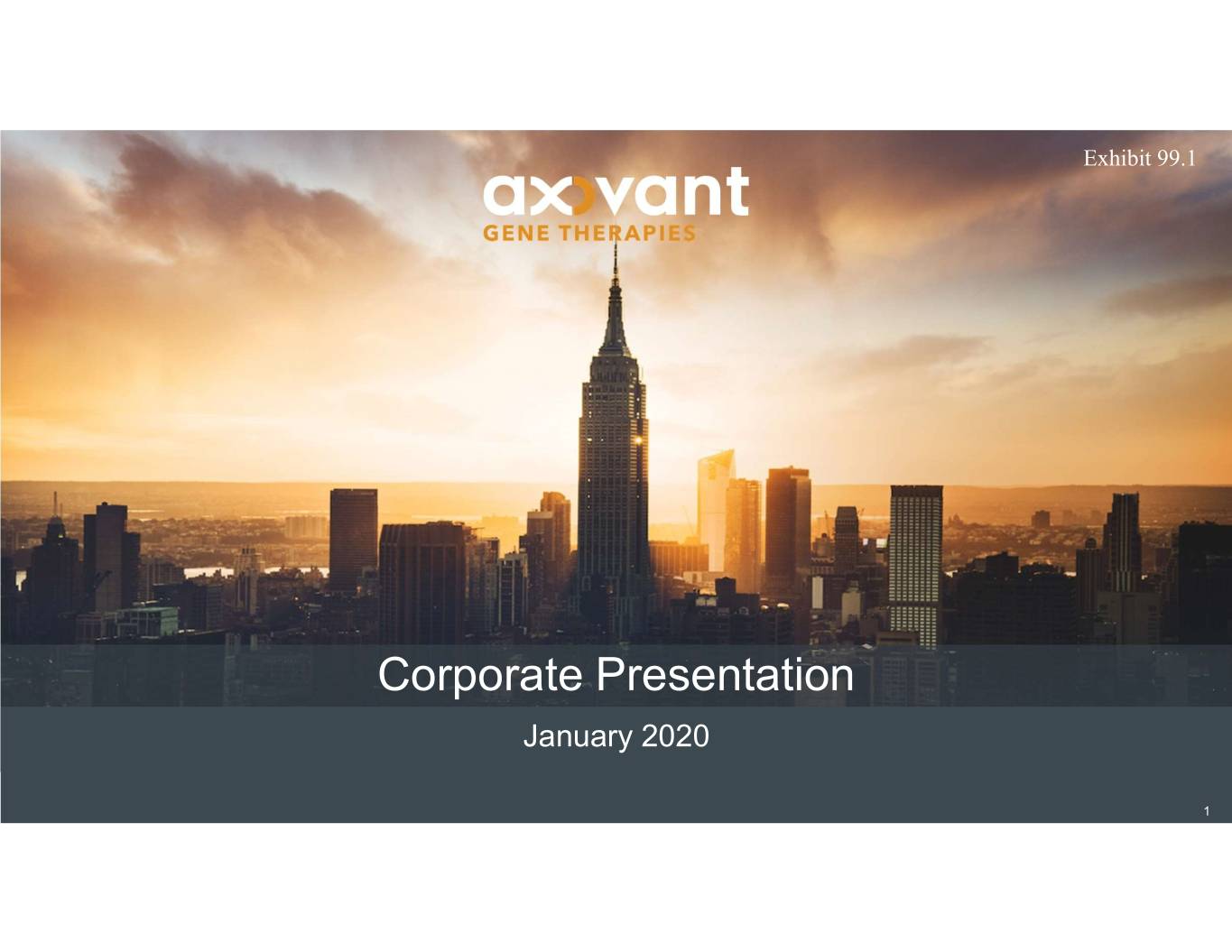
Exhibit 99.1 Corporate Presentation January 2020 1
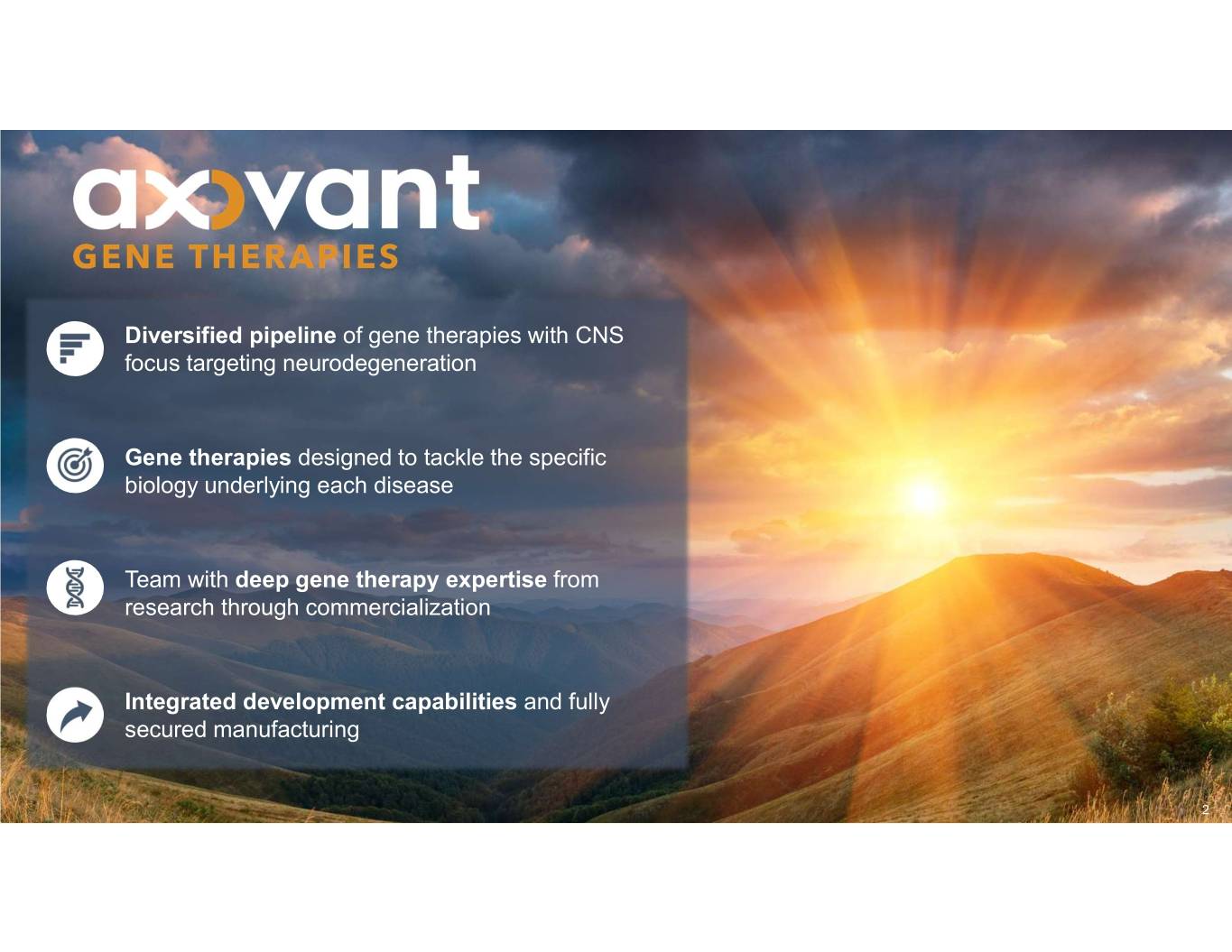
Diversified pipeline of gene therapies with CNS focus targeting neurodegeneration Gene therapies designed to tackle the specific biology underlying each disease Team with deep gene therapy expertise from research through commercialization Integrated development capabilities and fully secured manufacturing 2
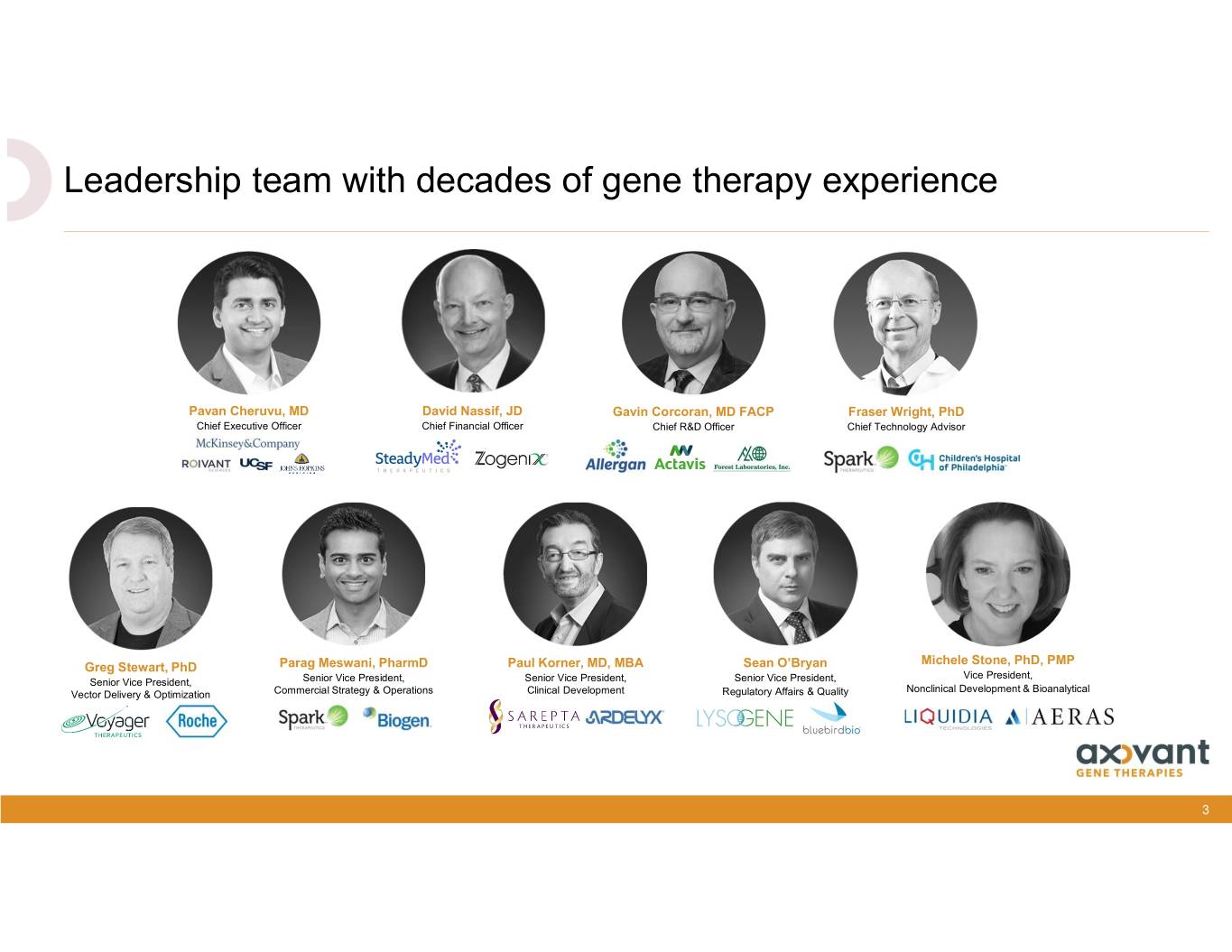
Leadership team with decades of gene therapy experience Pavan Cheruvu, MD David Nassif, JD Gavin Corcoran, MD FACP Fraser Wright, PhD Chief Executive Officer Chief Financial Officer Chief R&D Officer Chief Technology Advisor Michele Stone, PhD, PMP Greg Stewart, PhD Parag Meswani, PharmD Paul Korner, MD, MBA Sean O’Bryan Vice President, Senior Vice President, Senior Vice President, Senior Vice President, Senior Vice President, Nonclinical Development & Bioanalytical Vector Delivery & Optimization Commercial Strategy & Operations Clinical Development Regulatory Affairs & Quality 3
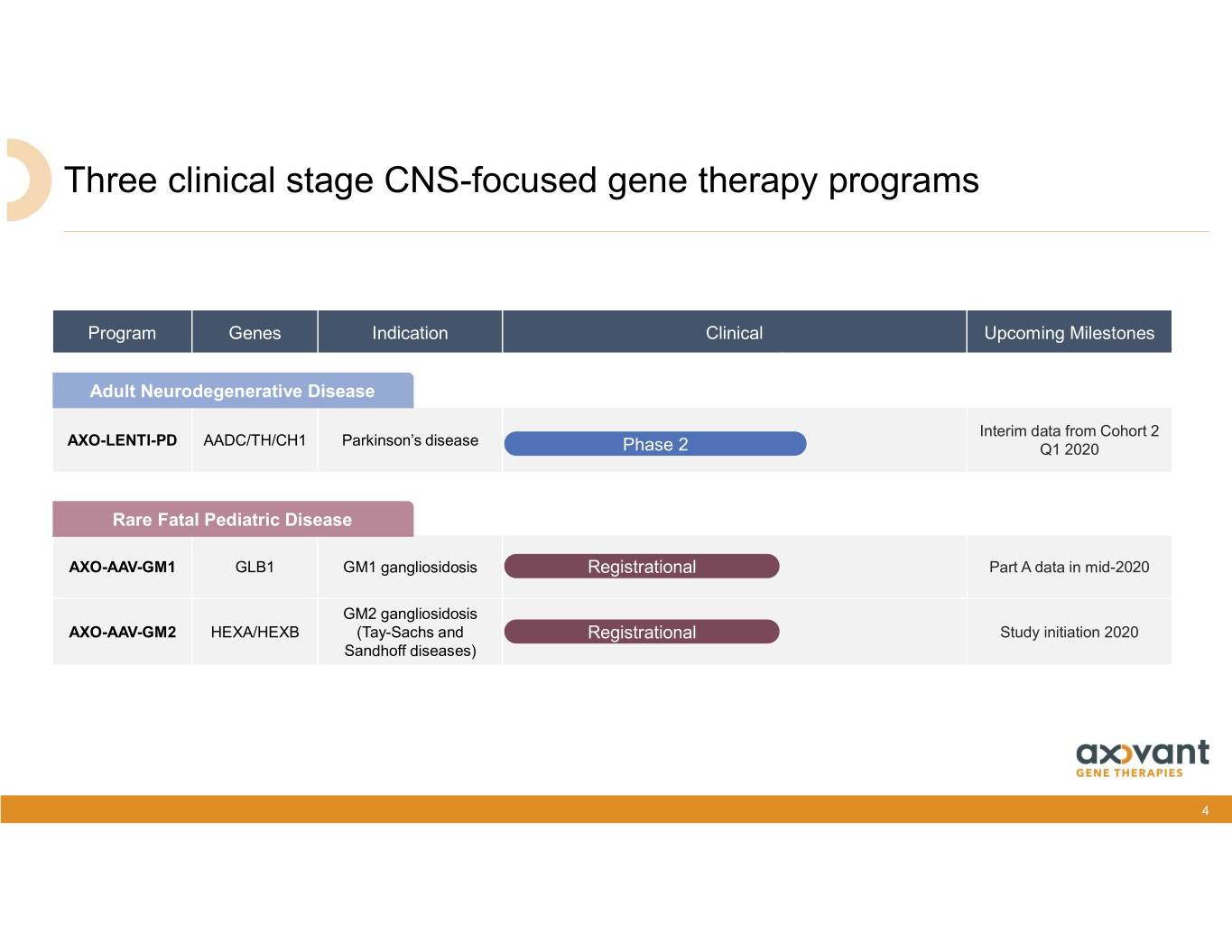
Three clinical stage CNS-focused gene therapy programs Program Genes Indication Clinical Upcoming Milestones Adult Neurodegenerative Disease Interim data from Cohort 2 AXO-LENTI-PD AADC/TH/CH1 Parkinson’s disease Phase 2 Q1 2020 Rare Fatal Pediatric Disease AXO-AAV-GM1 GLB1 GM1 gangliosidosis Registrational Part A data in mid-2020 GM2 gangliosidosis AXO-AAV-GM2 HEXA/HEXB (Tay-Sachs and Registrational Study initiation 2020 Sandhoff diseases) 4
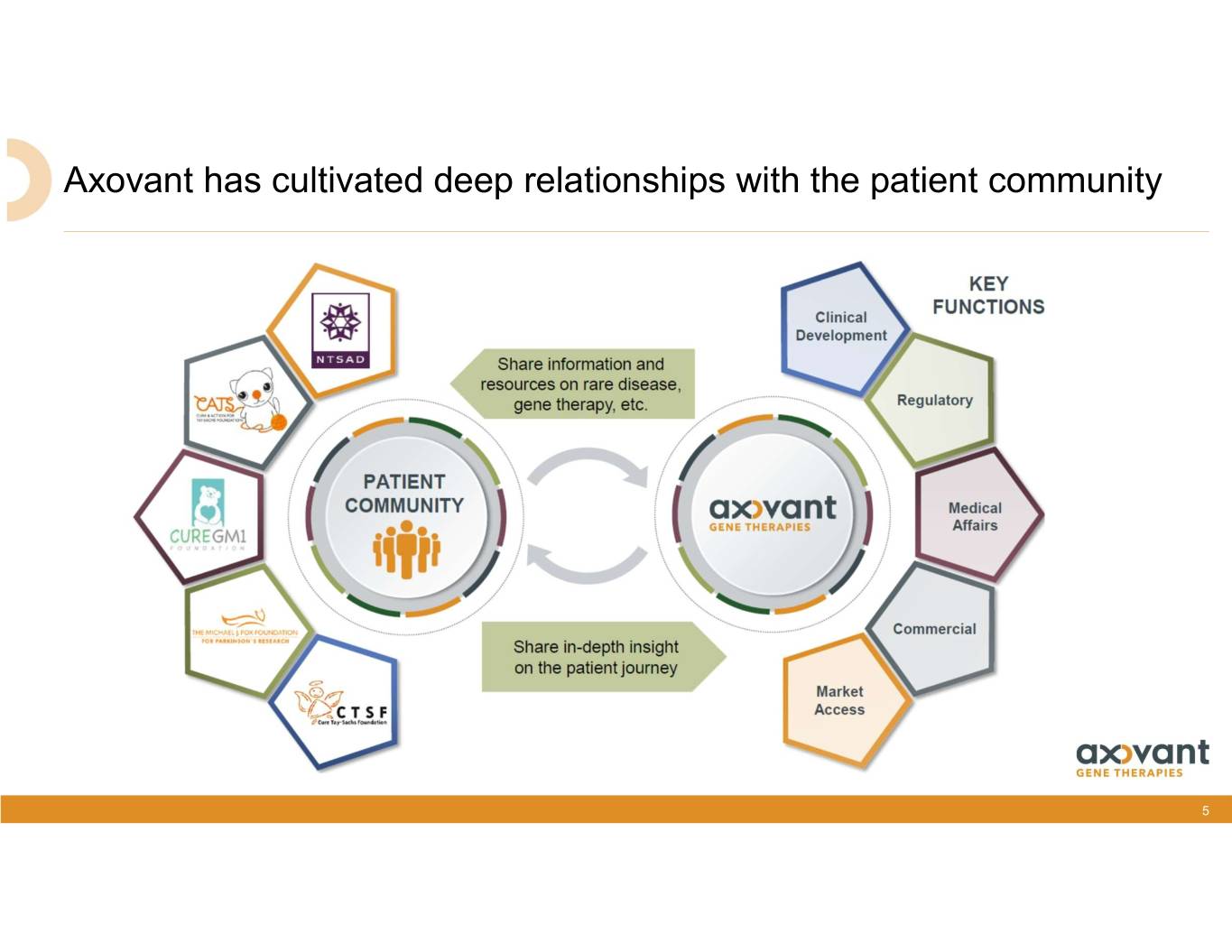
Axovant has cultivated deep relationships with the patient community 5
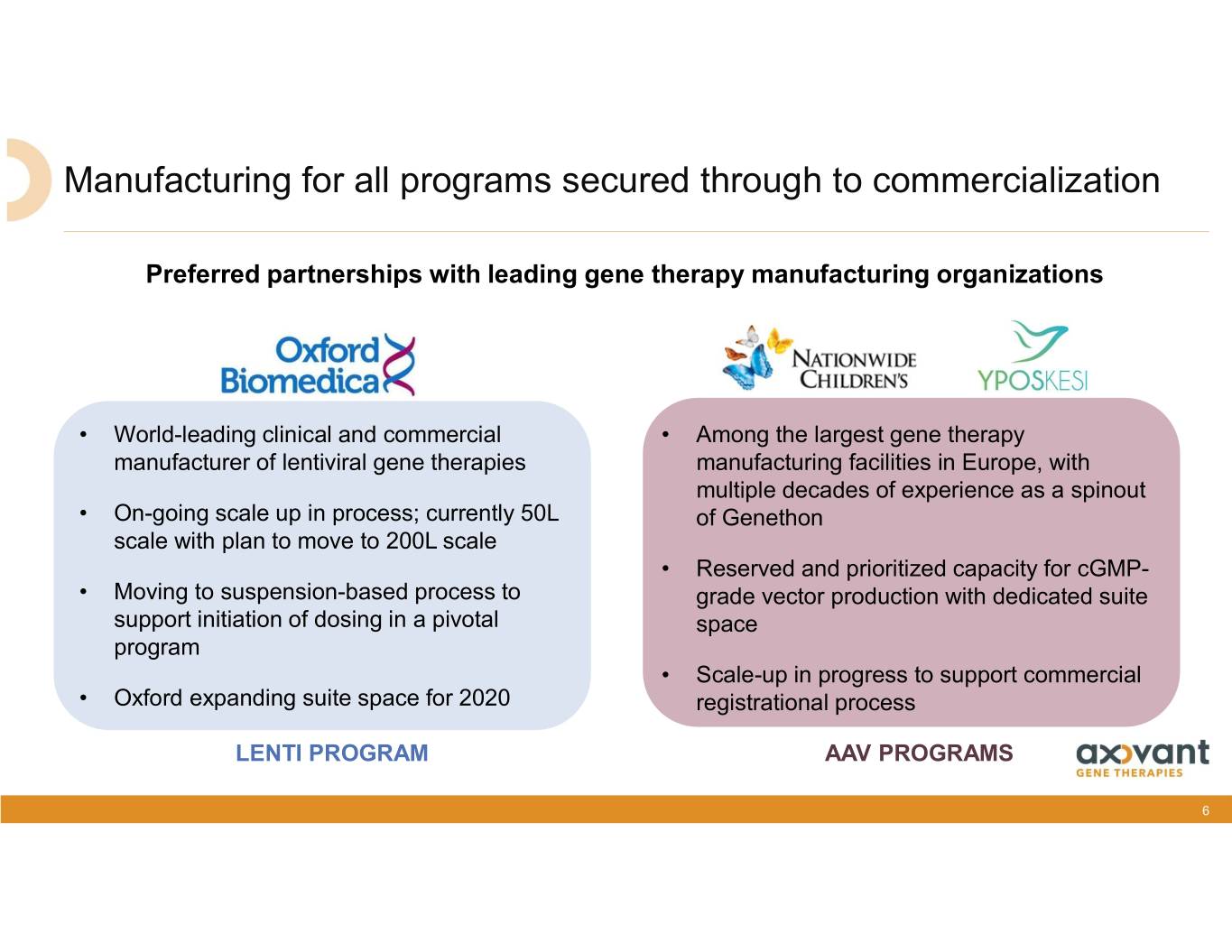
Manufacturing for all programs secured through to commercialization Preferred partnerships with leading gene therapy manufacturing organizations • World-leading clinical and commercial • Among the largest gene therapy manufacturer of lentiviral gene therapies manufacturing facilities in Europe, with multiple decades of experience as a spinout • On-going scale up in process; currently 50L of Genethon scale with plan to move to 200L scale • Reserved and prioritized capacity for cGMP- • Moving to suspension-based process to grade vector production with dedicated suite support initiation of dosing in a pivotal space program • Scale-up in progress to support commercial • Oxford expanding suite space for 2020 registrational process LENTI PROGRAM AAV PROGRAMS 6 6
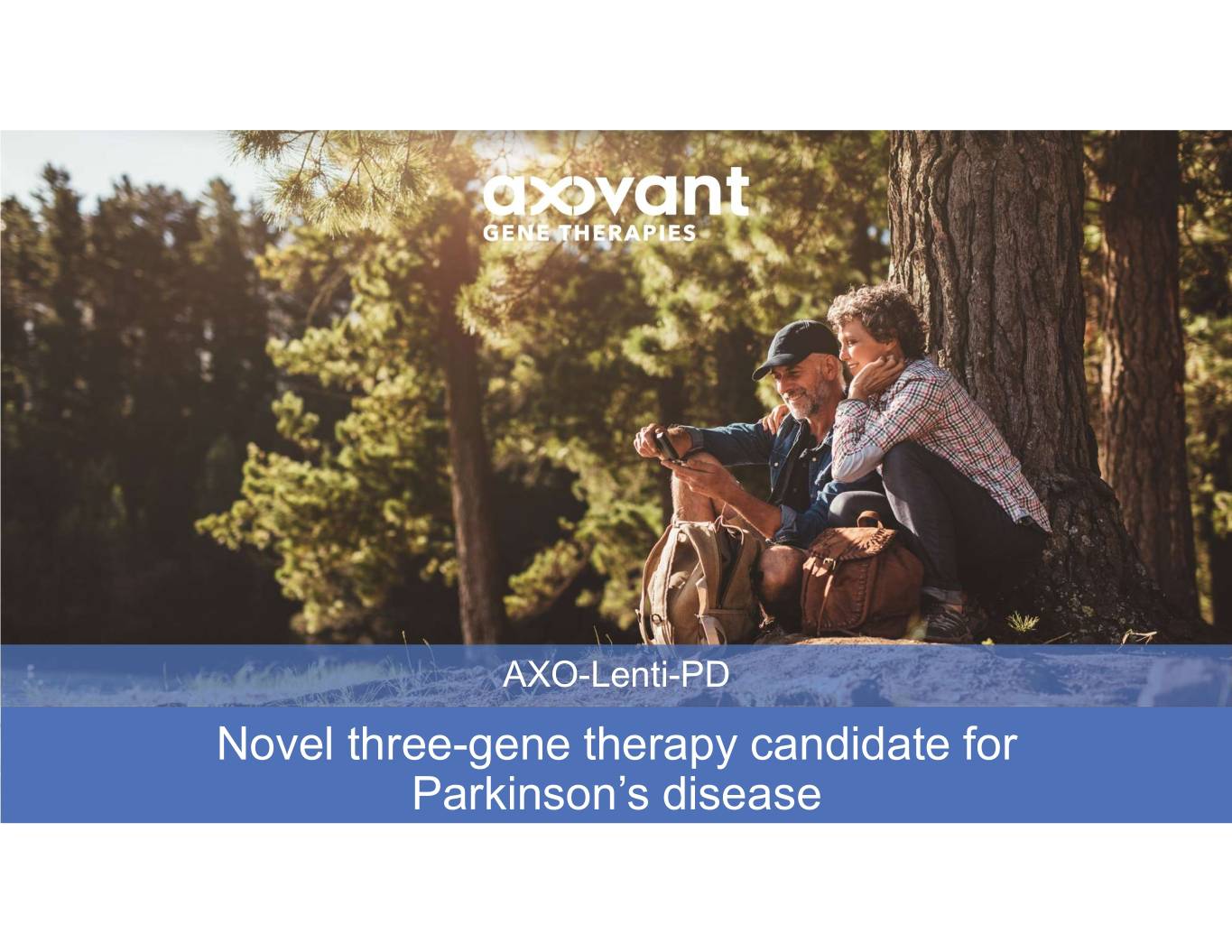
AXO-Lenti-PD Novel three-gene therapy candidate for Parkinson’s disease
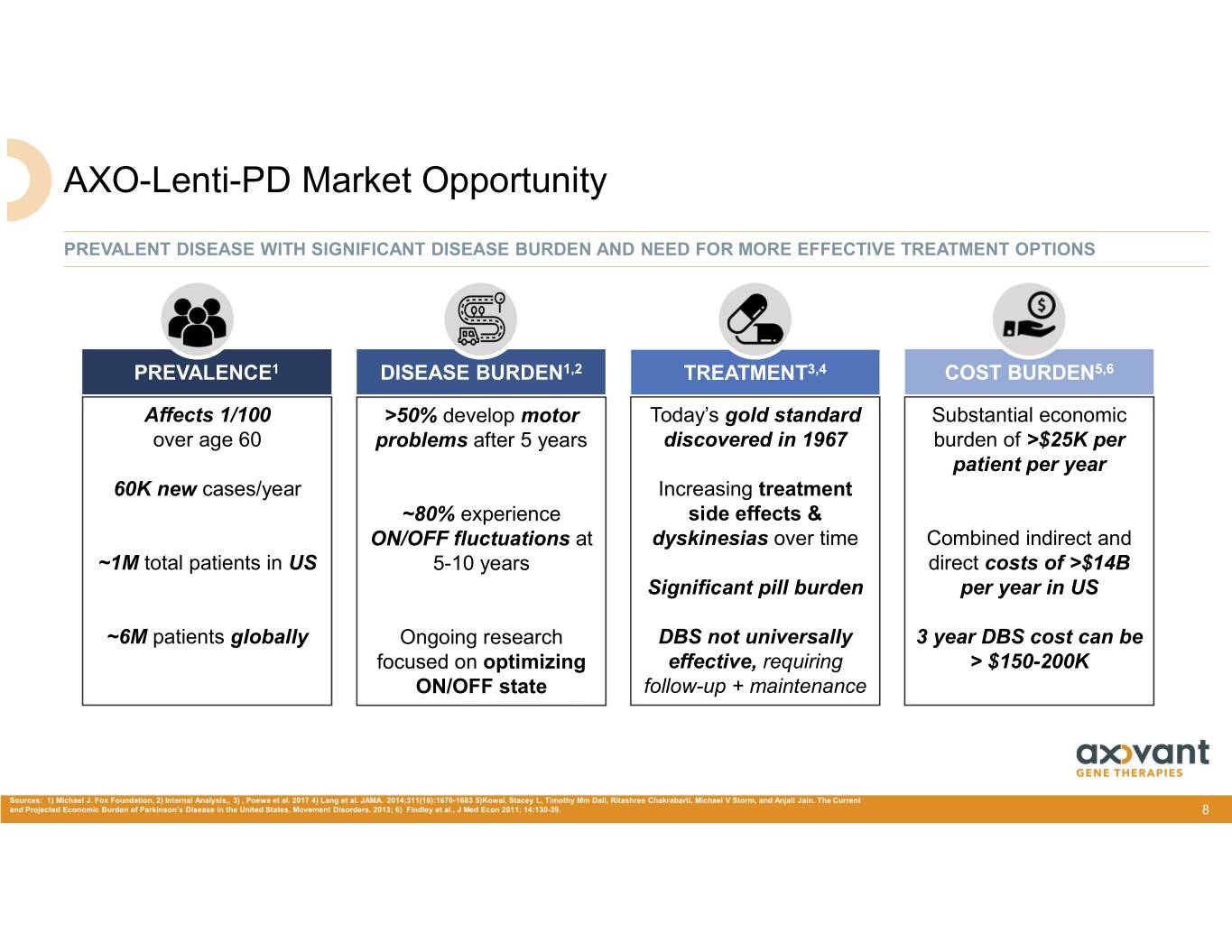
AXO-Lenti-PD Market Opportunity PREVALENT DISEASE WITH SIGNIFICANT DISEASE BURDEN AND NEED FOR MORE EFFECTIVE TREATMENT OPTIONS PREVALENCE1 DISEASE BURDEN1,2 TREATMENT3,4 COST BURDEN5,6 Affects 1/100 >50% develop motor Today’s gold standard Substantial economic over age 60 problems after 5 years discovered in 1967 burden of >$25K per patient per year 60K new cases/year Increasing treatment ~80% experience side effects & ON/OFF fluctuations at dyskinesias over time Combined indirect and ~1M total patients in US 5-10 years direct costs of >$14B Significant pill burden per year in US ~6M patients globally Ongoing research DBS not universally 3 year DBS cost can be focused on optimizing effective, requiring > $150-200K ON/OFF state follow-up + maintenance Sources: 1) Michael J. Fox Foundation, 2) Internal Analysis,, 3) , Poewe et al. 2017 4) Lang et al. JAMA. 2014;311(16):1670-1683 5)Kowal, Stacey L, Timothy Mm Dall, Ritashree Chakrabarti, Michael V Storm, and Anjali Jain. The Current and Projected Economic Burden of Parkinson’s Disease in the United States. Movement Disorders. 2013; 6) Findley et al., J Med Econ 2011; 14:130-39. 8
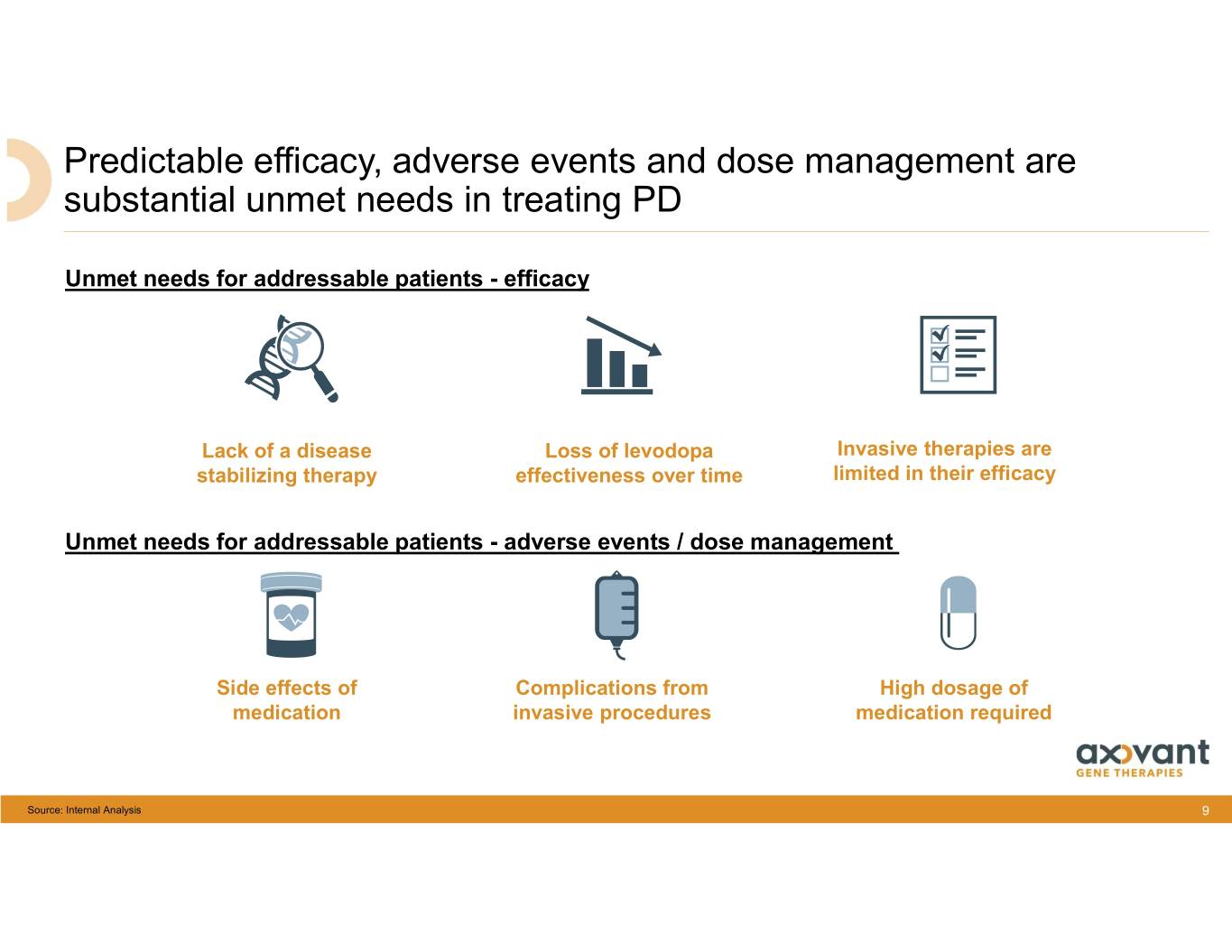
Predictable efficacy, adverse events and dose management are substantial unmet needs in treating PD Unmet needs for addressable patients - efficacy Lack of a disease Loss of levodopa Invasive therapies are stabilizing therapy effectiveness over time limited in their efficacy Unmet needs for addressable patients - adverse events / dose management Side effects of Complications from High dosage of medication invasive procedures medication required Source: Internal Analysis 9

Goals of therapy in Parkinson’s disease* “My entire body goes stiff…my mouth is often forced open in a painful position, or my mouth is forced “[Dyskinesia] so severe that ‘it looks like I’m closed with my tongue stuck out.” (Dystonia) having a seizure, and very painful.’” “The sudden inability to move my legs, as if they “I had terrible dyskinesias…I would knock over all were set in blocks of hardened concrete.” (Freezing) the glasses at the table [while eating].” Improve motor function Reduce dyskinesias and quality of life *FDA voice of the patient workshop 2016 10

AXO-Lenti-PD: a novel gene therapy candidate for Parkinson’s disease Three critical enzymes required for endogenous dopamine synthesis • Tyrosine hydroxylase (TH) and Cyclohydrolase 1 (CH1): converts tyrosine to L-dopa • Aromatic L-amino acid decarboxylase (AADC): converts L-dopa to dopamine Tyrosine Levodopa Dopamine CH1 TH AADC AXO-Lenti-PD contains three genes that encode these critical enzymes required for endogenous dopamine synthesis • Designed to restore steady, tonic levels of dopamine to reduce variability that leads to dyskinesia • Utilizes a lentiviral vector system with large gene packaging capacity • Stereotactic delivery via one-time infusion directly into the putamen, without need for intra-operative MRI 1: Azzouz, et al. J Neurosci. 2002;22(23):10302-12. 2: Jarraya, et al, Sci Transl Med. 2009;1(2):2ra4. 11
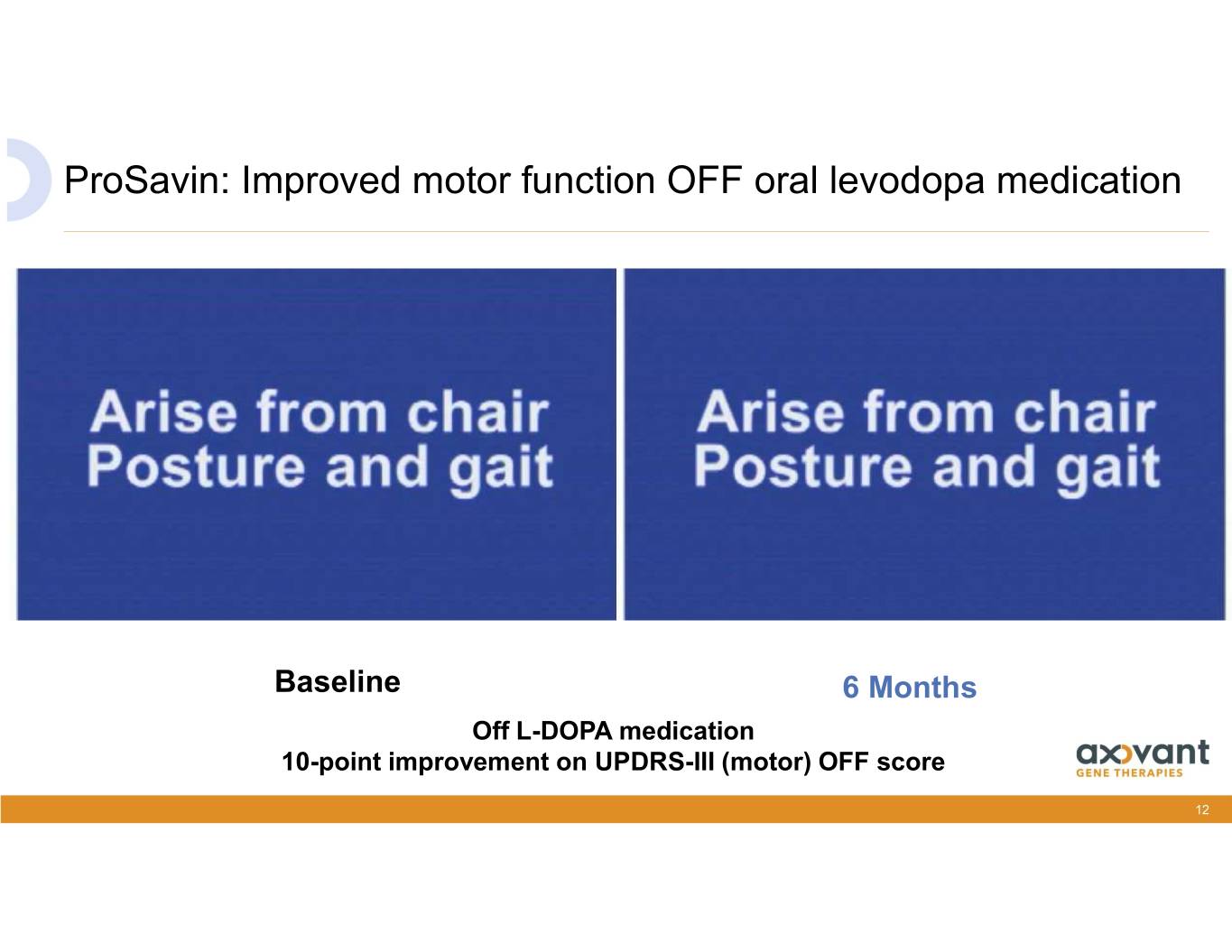
ProSavin: Improved motor function OFF oral levodopa medication Baseline 6 Months Off L-DOPA medication 10-point improvement on UPDRS-III (motor) OFF score 12
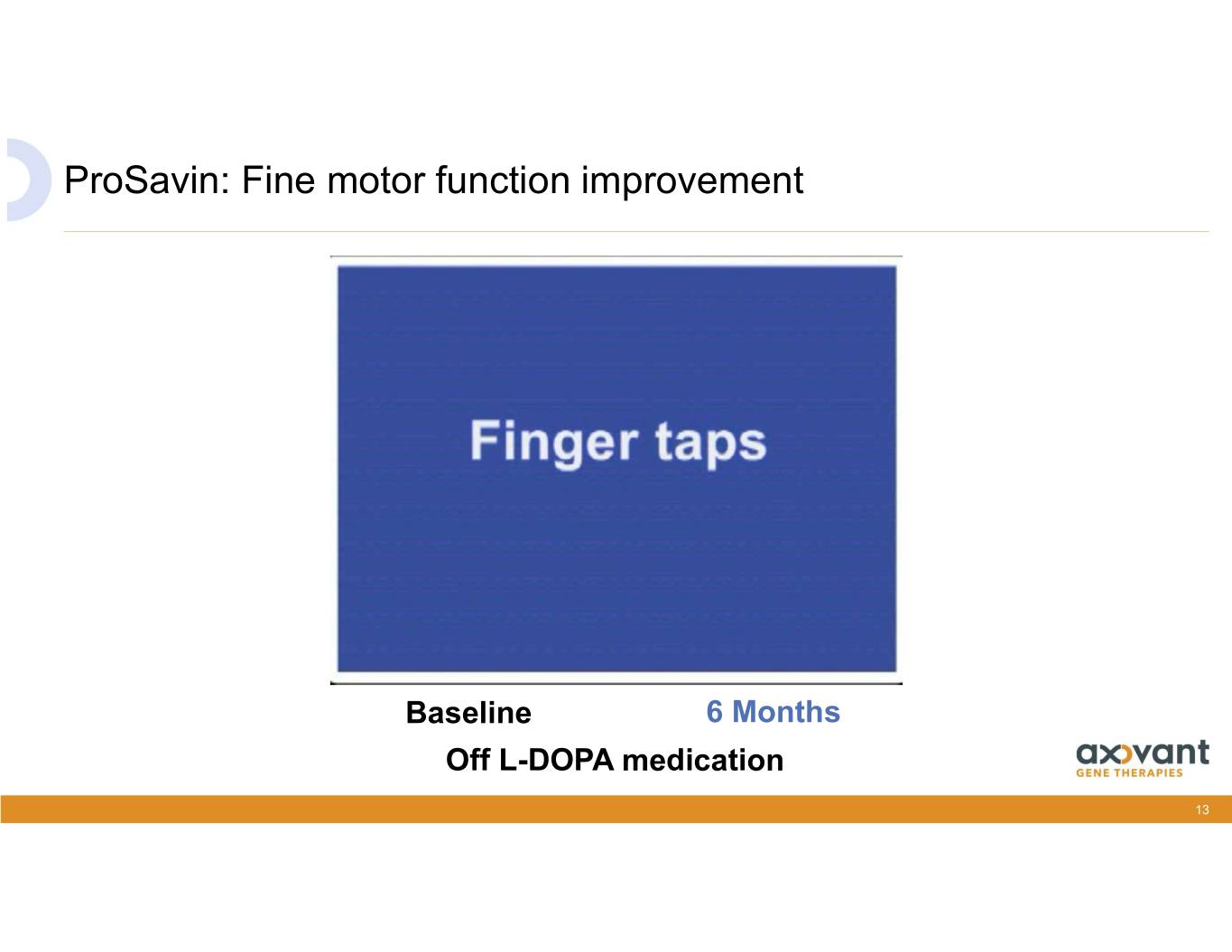
ProSavin: Fine motor function improvement Baseline 6 Months Off L-DOPA medication 13

Lentiviral vector is neurotropic1-2 Immunofluorescence analysis of transgene expression from Transgene expression (TH, AADC, CH1) MPTP-lesioned ProSavin vector five months post injection into rat striatum1 non-human primates2 CHI- TH AADC • Observed transgene expression co-localizes with neuronal specific marker (yellow) • Transgene expression in vivo is found away from the site of injection indicates convection. Neuron-specific expression of the transgenes can be observed CH-1 • Neuronal observed to be the primary cell type transduced by the vector, co-localized to >90% neuronal cells in MPTP non-human primates 1: Azzouz, et al. J Neurosci. 2002;22(23):10302-12. 2: Jarraya, et al, Sci Transl Med. 2009;1(2):2ra4. 14
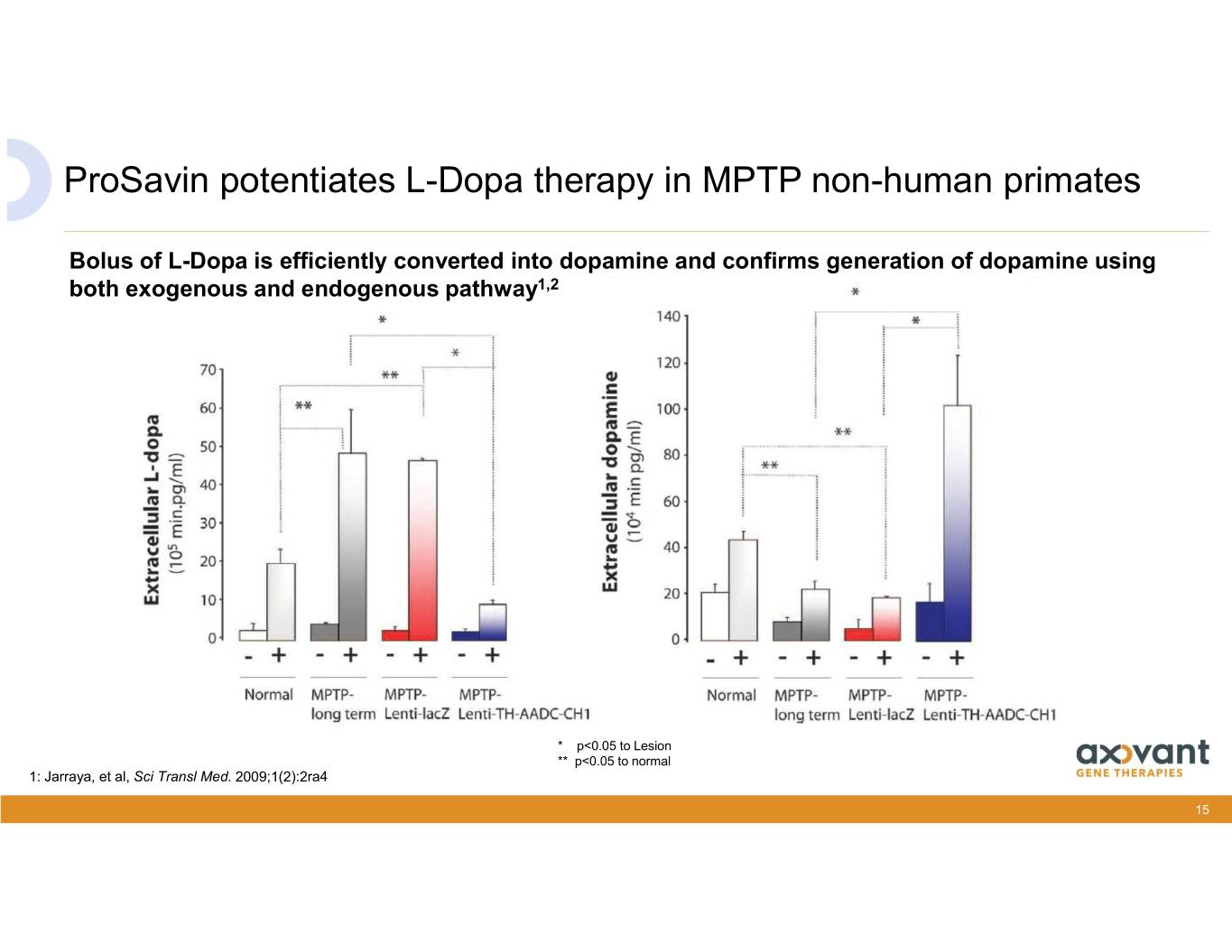
ProSavin potentiates L-Dopa therapy in MPTP non-human primates Bolus of L-Dopa is efficiently converted into dopamine and confirms generation of dopamine using both exogenous and endogenous pathway1,2 * p<0.05 to Lesion ** p<0.05 to normal 1: Jarraya, et al, Sci Transl Med. 2009;1(2):2ra4 15

Decreased dyskinesia observed in L-Dopa-induced non-human primate model (LID-MPTP) with ProSavin LID-MPTP + L-DOPA Dyskinesia events in Levodopa-induced-dyskinesia MPTP non-human primates 1600 ON L-Dopa State 1400 1200 ON L-DOPA 1000 20mg/kg 800 * * 600 * * * LID-MPTP model 400 generated via long-term 200 treatment with L-dopa 0 until severe dyskinesias Total Numbers dyskinesiaof / 6hours have developed MPTP LID 0-1M 1-2M 3-6M Lentiviral vector injection MPTP-LID-ProSavin group MPTP-LID- Lenti-lacZ group LID-MPTP-ProSavin + L-DOPA Figure adapted from Jarraya, et al, Sci Transl Med. 2009;1(2):2ra4. 16
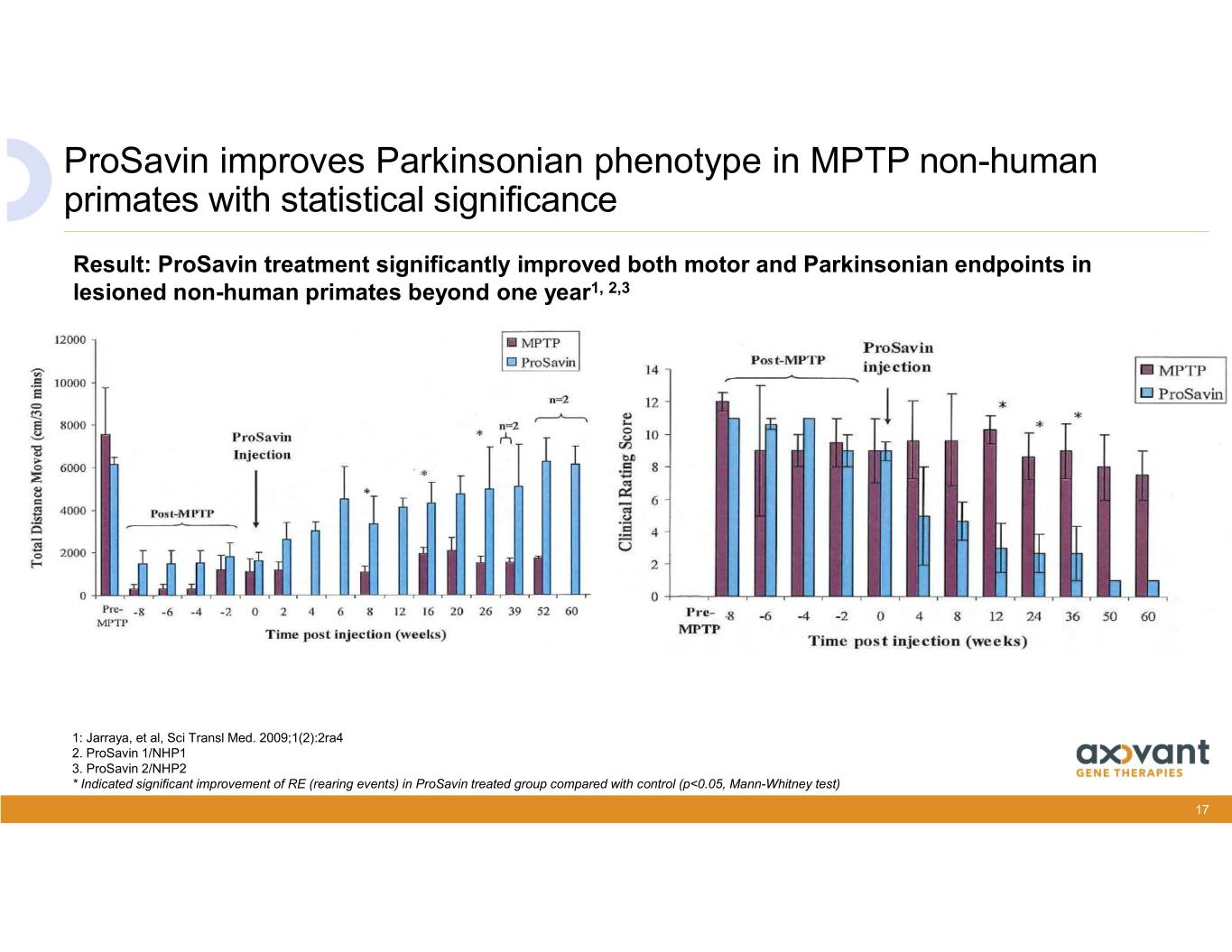
ProSavin improves Parkinsonian phenotype in MPTP non-human primates with statistical significance Result: ProSavin treatment significantly improved both motor and Parkinsonian endpoints in lesioned non-human primates beyond one year1, 2,3 1: Jarraya, et al, Sci Transl Med. 2009;1(2):2ra4 2. ProSavin 1/NHP1 3. ProSavin 2/NHP2 * Indicated significant improvement of RE (rearing events) in ProSavin treated group compared with control (p<0.05, Mann-Whitney test) 17

ProSavin: Durable and dose-dependent benefit seen in UPDRS Part III OFF scores Mean UPDRS-III (Motor) OFF Score over 6 years1 UPDRS-III (Motor) OFF Score at Month 122 20.0 18.0 16.0 14.0 12.0 10.0 8.0 6.0 Improvement Improvement at Months 12 UPDRS Part (Motor) III Score 4.0 2.0 0.0 Cohort 1 Cohort 2 Cohort 3 1.9x107 TU 4.0x107 TU 1.0x108 TU Patients experienced a sustained benefit on the UPDRS Part III (motor) OFF score over six years after treatment with ProSavin. By contrast, UPDRS Part III (motor) OFF scores are expected to worsen by 3-4 points per year in this population2 Mean UPDRS III (OFF) scores pooled across low, mid, and high dose 1: Palfi, et al, Hum Gene Ther Clin Dev. 2018;29(3):148-155. cohorts. Assessments post-deep brain stimulation (DBS) are excluded. 2: Palfi, et al. The Lancet. 2014;383(9923):1138-1146 *Studies not conducted by either Oxford Biomedica or Axovant 18
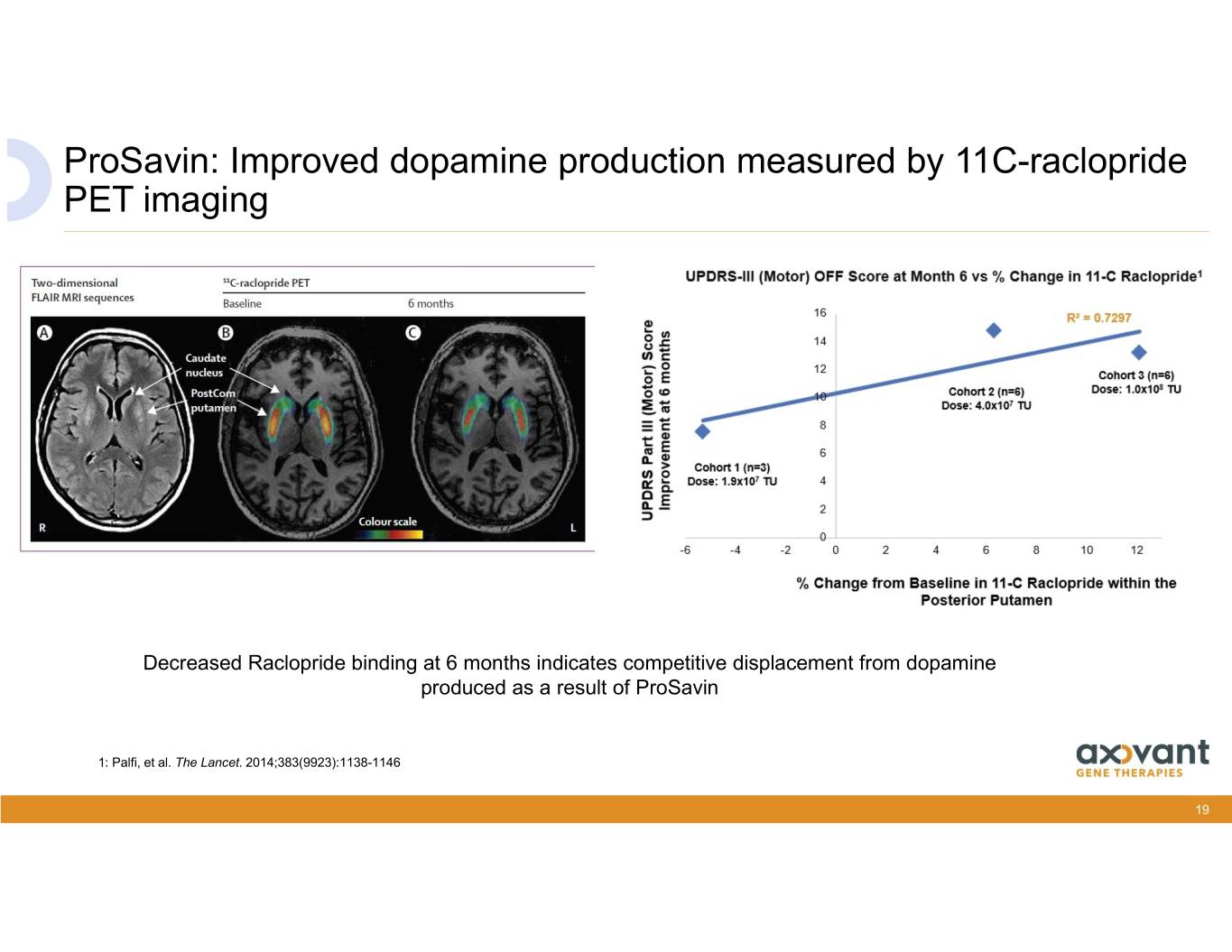
ProSavin: Improved dopamine production measured by 11C-raclopride PET imaging Decreased Raclopride binding at 6 months indicates competitive displacement from dopamine produced as a result of ProSavin 1: Palfi, et al. The Lancet. 2014;383(9923):1138-1146 19

AXO-Lenti-PD: Re-engineered to increase dopamine production ProSavin ProSavin + 13 different constructs studied in multiple experiments leading to final selection of AXO-Lenti-PD as the optimal design to move forward AXO-Lenti-PD • Gene order • Protein fusion using GS15 linker • IRES sequence Result 1: Fusion of TH and CH1 at start of expression cassette generated highest level of catecholamine production Result 2: Use of modified GS15 linker increased dopamine production Stewart, et al. Hum Gene Ther Clin Dev. 2016;27(3):100-110. 20
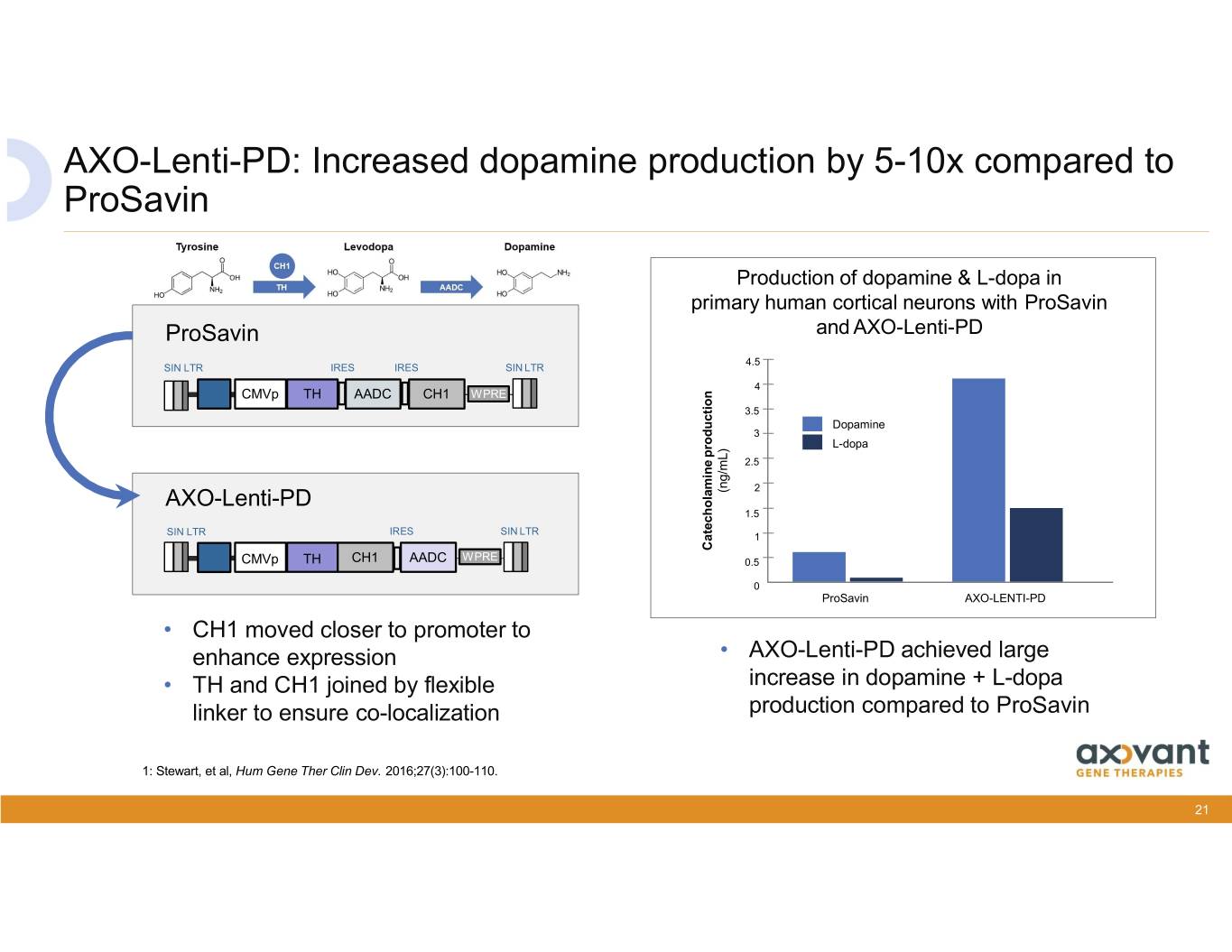
AXO-Lenti-PD: Increased dopamine production by 5-10x compared to ProSavin Production of dopamine & L-dopa in primary human cortical neurons with ProSavin ProSavin and AXO-Lenti-PD 4.5 SIN LTR IRES IRES SIN LTR 4 CMVp TH AADC CH1 WPRE 3.5 Dopamine 3 L-dopa 2.5 AXO-Lenti-PD (ng/mL) 2 1.5 IRES SIN LTR SIN LTR 1 aehlmn production Catecholamine CMVp TH CH1 AADC WPRE 0.5 0 ProSavin AXO-LENTI-PD • CH1 moved closer to promoter to enhance expression • AXO-Lenti-PD achieved large • TH and CH1 joined by flexible increase in dopamine + L-dopa linker to ensure co-localization production compared to ProSavin 1: Stewart, et al, Hum Gene Ther Clin Dev. 2016;27(3):100-110. 21

AXO-Lenti-PD produces statistically significant improvements in motor function in nonhuman primates compared to placebo PD clinical score improved with treatment and with 1/5th the dose of ALPD Null LacZ ProSavin (2E+7 TU) ALPD LD (4E+6 TU) * ALPD HD (2E+7 TU) ** • Experiment carried out without L-DOPA administration • Monkey species: M. fascicularis 1: PCS0148/20060333TCYB 2: Badin, et al. Mol Ther Meth and Clin Dev 2019;14: 206-216 22

AXO-Lenti-PD: Generates dose-dependent expression of AADC, TH, and CH1 in transduced striatal cells in primate models Expression Levels of CH1, AADC, and TH in Transduced Striatal Cells of MPTP non-human primates (A) Representative coronal sections showing histochemical staining for CH1 (left column), AADC (middle column), and TH (right column). Coronal brain sections were prepared in study animals 6 months post- vector administration with EIAV-Null (I), ProSavin (II), OXB-102 LD (III), and OXB-102 HD (IV). Scale bar: 50mm. (B) Transduction volumes showing the percentage volume (in cubic millimeters) of TH, CH1, and AADC transgene expression in the putamen of ProSavin, OXB-102 LD, and OXB-102 HD treatment groups. Values are presented as mean ± SEM. (C) Gene expression in striatal cells transduced with OXB- 102. Immunohistochemistry showing AADC staining (green) and RNAScope showing mRNA levels of Th (red) in the putamen of non-human primates 6 months after OXB-102 injection. DAPI-positive cell nuclei are shown in blue, and colocalization of all markers is shown in the last column. Scale bars: 20 mm (I), 10 mm (II), and 5 mm (III). Badin, et al. Molecular Therapy. 2019 23

AXO-Lenti-PD: Nonclinical Summary AXO-Lenti-PD restores tonic levels of dopamine in the putamen similar to the healthy physiological state of normal individuals Substantial efficacy and safety data package for both ProSavin (1st generation vector) and AXO- Lenti-PD (2nd generation vector) • 13 pharmacology studies, 7 safety/toxicology studies conducted, 3 carcinogenicity studies • Strong efficacy and safety observed in both rat and non-human primate PD models with ProSavin • Enhanced PK and PD observed in vitro and in vivo with AXO-Lenti-PD • 5-10x improvement in dopamine production in vitro and in vivo • Equivalent doses of AXO-Lenti-PD demonstrated better efficacy than ProSavin • Clean toxicology packages for both vectors 24
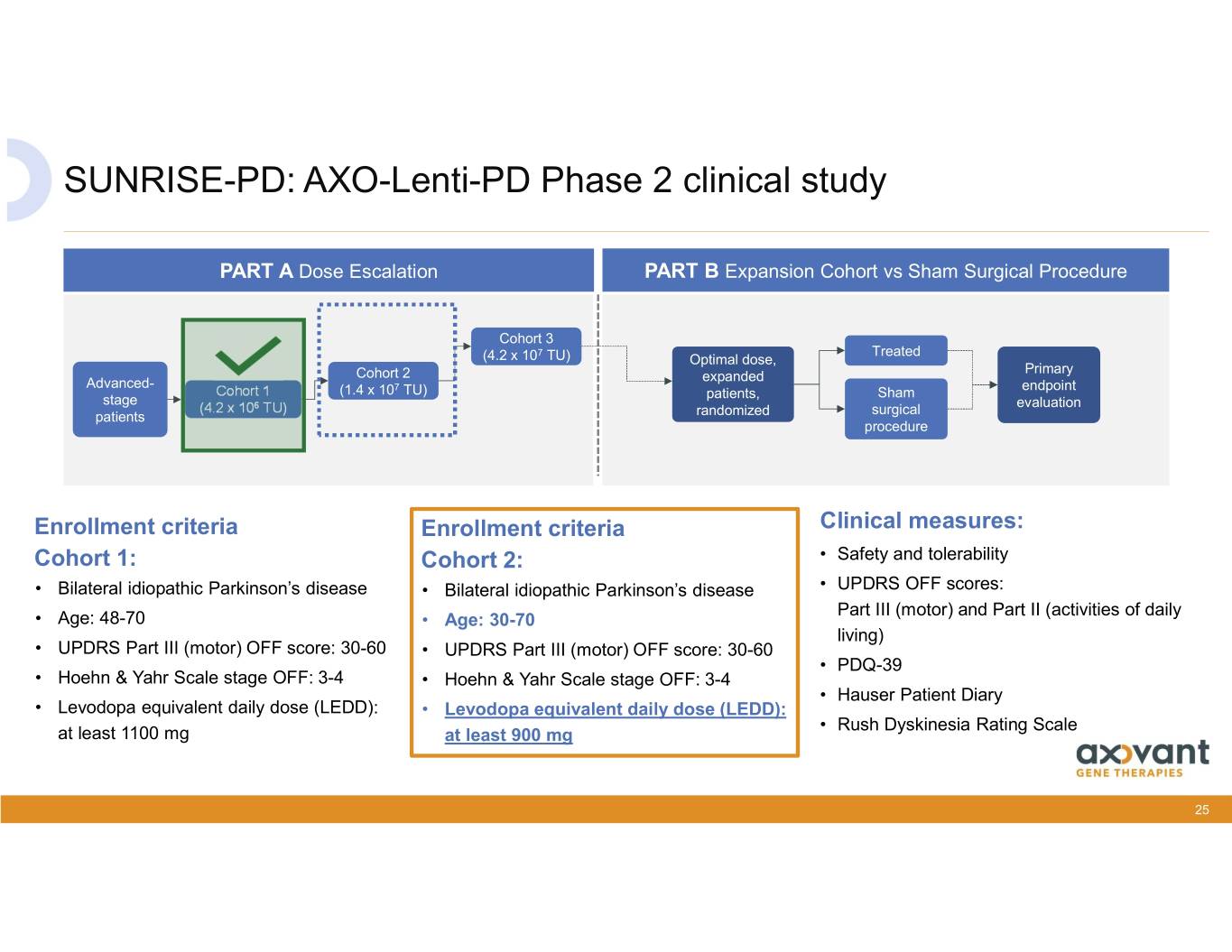
SUNRISE-PD: AXO-Lenti-PD Phase 2 clinical study PART A Dose Escalation PART B Expansion Cohort vs Sham Surgical Procedure Cohort 3 7 Treated (4.2 x 10 TU) Optimal dose, Primary Cohort 2 expanded Advanced- 7 endpoint Cohort 1 (1.4 x 10 TU) patients, Sham stage evaluation (4.2 x 106 TU) surgical patients randomized procedure Enrollment criteria Enrollment criteria Clinical measures: Cohort 1: Cohort 2: • Safety and tolerability • Bilateral idiopathic Parkinson’s disease • Bilateral idiopathic Parkinson’s disease • UPDRS OFF scores: Part III (motor) and Part II (activities of daily • Age: 48-70 • Age: 30-70 living) • UPDRS Part III (motor) OFF score: 30-60 • UPDRS Part III (motor) OFF score: 30-60 • PDQ-39 • Hoehn & Yahr Scale stage OFF: 3-4 • Hoehn & Yahr Scale stage OFF: 3-4 • Hauser Patient Diary • Levodopa equivalent daily dose (LEDD): • Levodopa equivalent daily dose (LEDD): • Rush Dyskinesia Rating Scale at least 1100 mg at least 900 mg 25

AXO-Lenti-PD: Potential to address greatest patient needs Consistent patient benefit across multiple objective measures in Cohort 1 at 12 months (n=2) Safety and tolerability Observed to be generally well-tolerated with no serious adverse events related to therapy Improved motor 22-point mean improvement in the UPDRS Part III (motor) OFF score with AXO-Lenti-PD function Improved Increased ON time without dyskinesia and decrease in ON time with troublesome dyskinesia dyskinesias Improved 13-point (44%) improvement in UPDRS Part II (activities of daily living) OFF score and 15-point (30%) quality of life mean improvement in PDQ-39 Summary Index Score 26

Clinical dose-response observed in motor function across four dose cohorts including ProSavin and AXO-Lenti-PD in human subjects UPDRS-III (Motor) OFF Score at Month 12 (cross-study comparison)1 25 20 15 22 10 15 5 11 Average UPDRS Part III (Motor) III AveragePart UPDRS 7 Score Improvement at 12 Months 12 at ImprovementScore 0 ProSavin Cohort 1 ProSavin Cohort 2 ProSavin Cohort 3 AXO-Lenti-PD Cohort 1 (n=3) (n=6) (n=6) (n=2) Target Dose: 1.9x107 TU Target Dose: 4.0x107 TU Target Dose: 1.0x108 TU Target Dose: 4.2x106 TU 1: Palfi, et al. The Lancet. 2014;383(9923):1138-1146 Note: Error bars are calculated as (Mean +/- SEM) 27

AXO-Lenti-PD: Hauser diary at 3, 6 and 12 months 16.0 “Good” ON Time 14.0 ON time without dyskinesia 12.0 8.0 10.1 ON time with non-troublesome dyskinesia 10.0 10.7 11.3 8.0 ON time with troublesome dyskinesia Hours OFF time 6.0 4.6 2.4 4.0 0.2 2.0 3.0 1.5 2.0 3.4 2.7 1.8 1.4 0.0 Baseline Month 3 Month 6 Month 12* * 12 month includes one patient who was able to record a diary 28

AXO-Lenti-PD: Effect on UPDRS Part III (Motor) OFF score 30 25 24 20 20 20 22-points average improvement at month 12 15 14 13 12 10 ProSavin Month 6 ProSavin Month 12 Improvement in UPDRS (Motor) Part III OFF Score 5 AXO-Lenti-PD Month 6 AXO-Lenti-PD Month 12 0 ProSavin All Cohorts (n=15) Patient A Patient B AXO-Lenti-PD 29
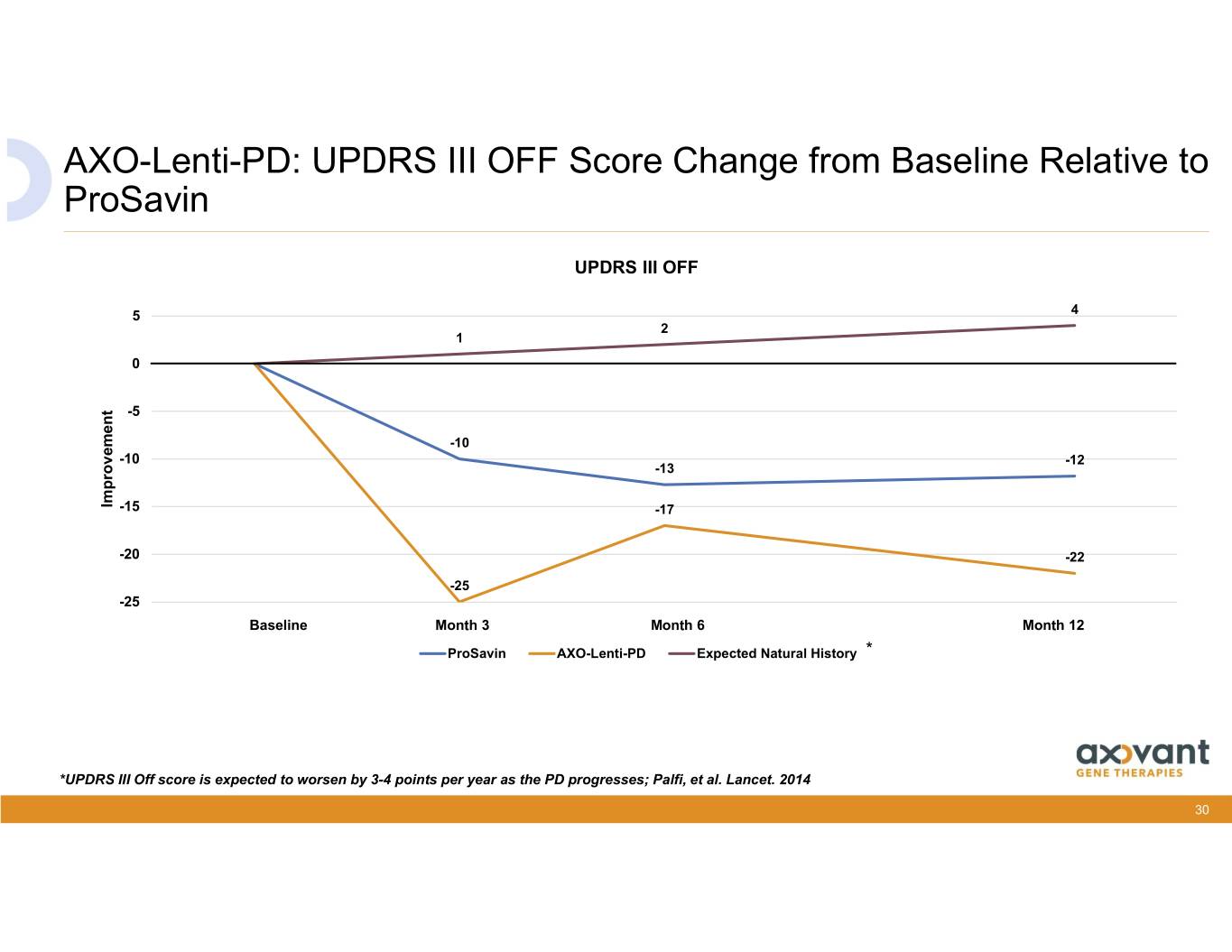
AXO-Lenti-PD: UPDRS III OFF Score Change from Baseline Relative to ProSavin UPDRS III OFF 5 4 2 1 0 -5 -10 -10 -12 -13 Improvement -15 -17 -20 -22 -25 -25 Baseline Month 3 Month 6 Month 12 ProSavin AXO-Lenti-PD Expected Natural History * *UPDRS III Off score is expected to worsen by 3-4 points per year as the PD progresses; Palfi, et al. Lancet. 2014 30

AXO-Lenti-PD: Effect on UPDRS Part II (Activities of Daily Living) OFF score 30 26 25 20 16 15 Score 13 13-point (44%) 10 improvement at month 12 10 ProSavin Month 6 5 4 4 ProSavin Month 12 Improvement in UPDRS Part II (ADLs) OFF OFF II (ADLs)Part UPDRS in Improvement AXO-Lenti-PD Month 6 0 AXO-Lenti-PD Month 12 ProSavin All Cohorts (n=15) Patient A Patient B AXO-Lenti-PD 31
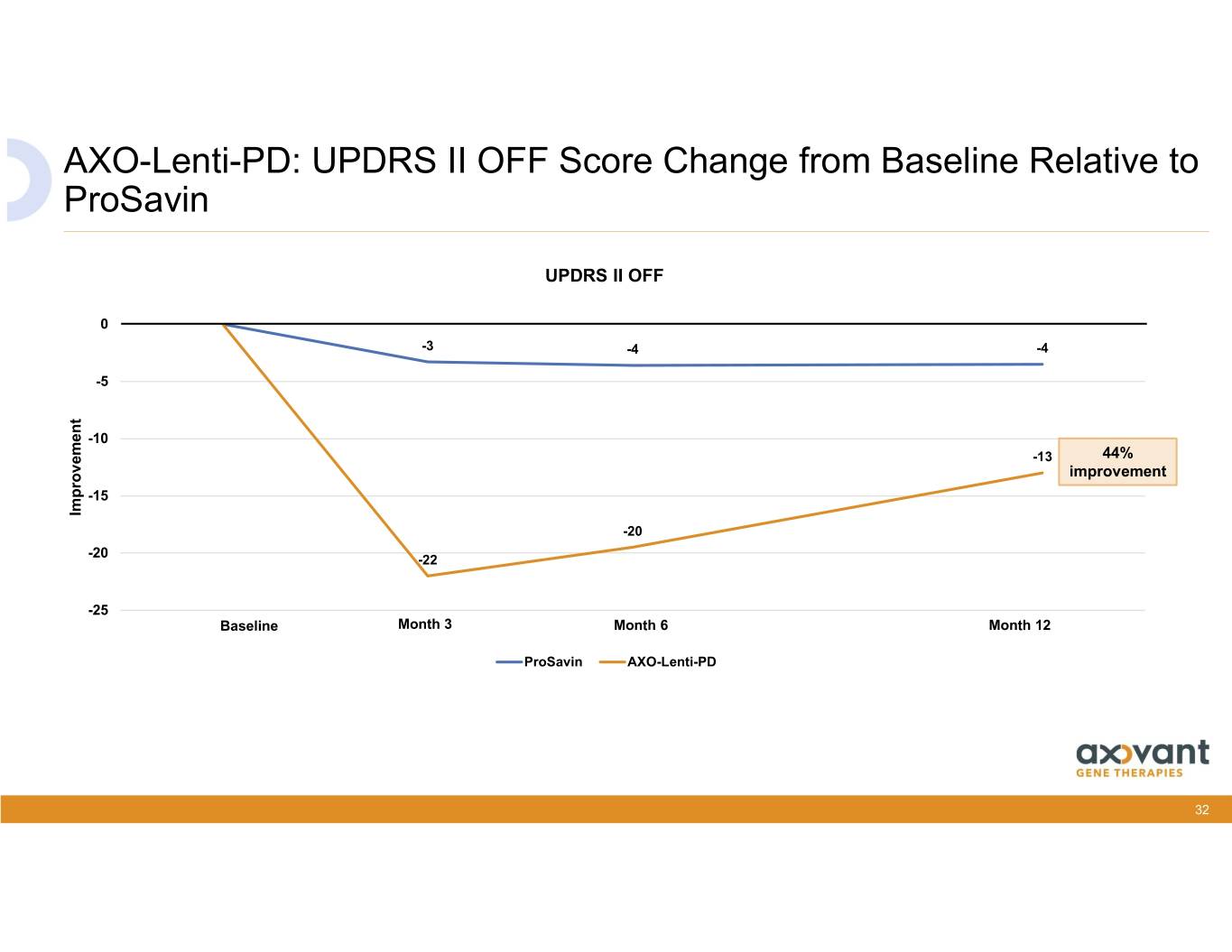
AXO-Lenti-PD: UPDRS II OFF Score Change from Baseline Relative to ProSavin UPDRS II OFF 0 -3 -4 -4 -5 -10 -13 44% improvement -15 Improvement -20 -20 -22 -25 Baseline Month 3 Month 6 Month 12 ProSavin AXO-Lenti-PD 32
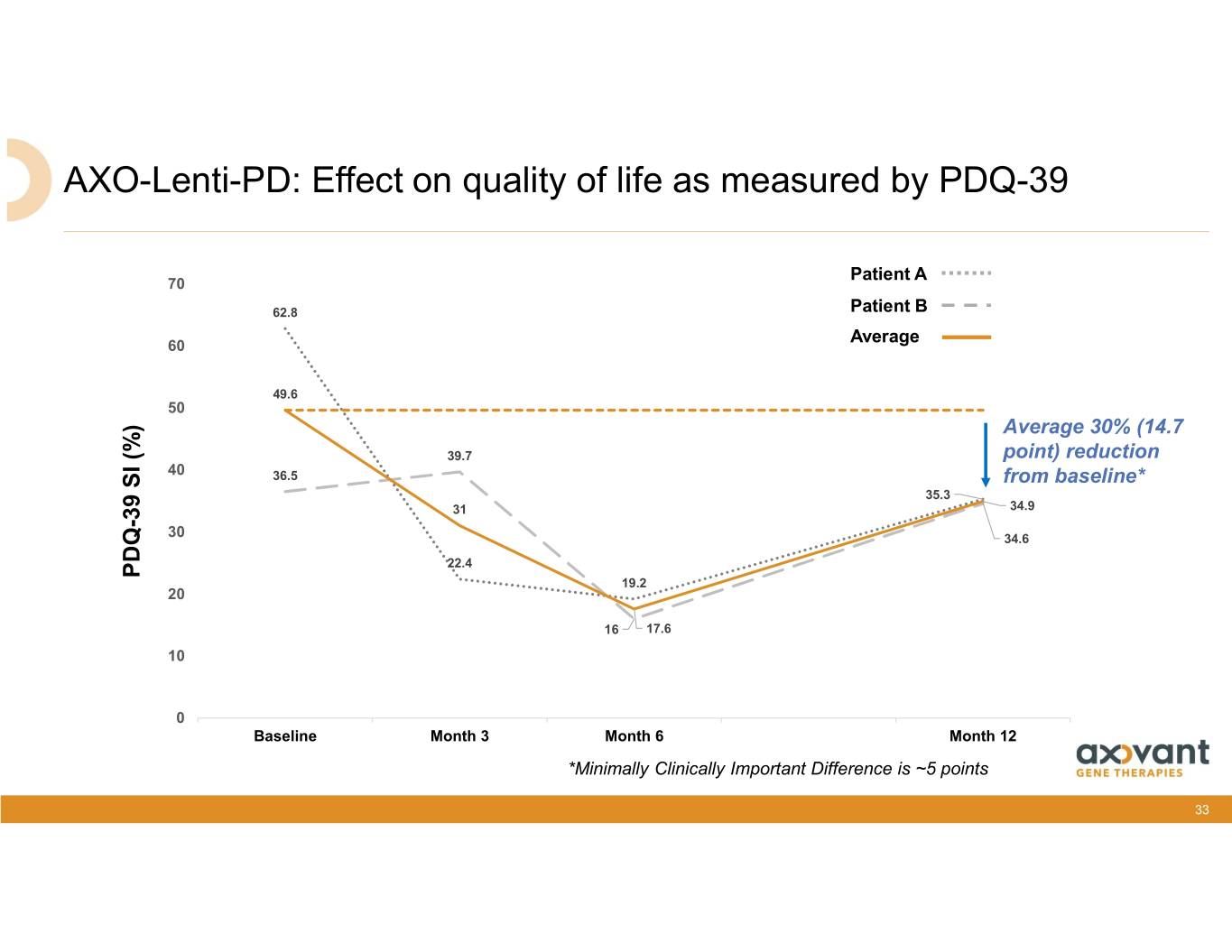
AXO-Lenti-PD: Effect on quality of life as measured by PDQ-39 Patient A 70 62.8 Patient B Average 60 49.6 50 Average 30% (14.7 39.7 point) reduction 40 36.5 from baseline* 35.3 31 34.9 30 34.6 22.4 PDQ-39 SI(%) 19.2 20 16 17.6 10 0 Baseline Month 3 Month 6 Month 12 *Minimally Clinically Important Difference is ~5 points 33

AXO-Lenti-PD Market Opportunity NASDAQ: AXGT
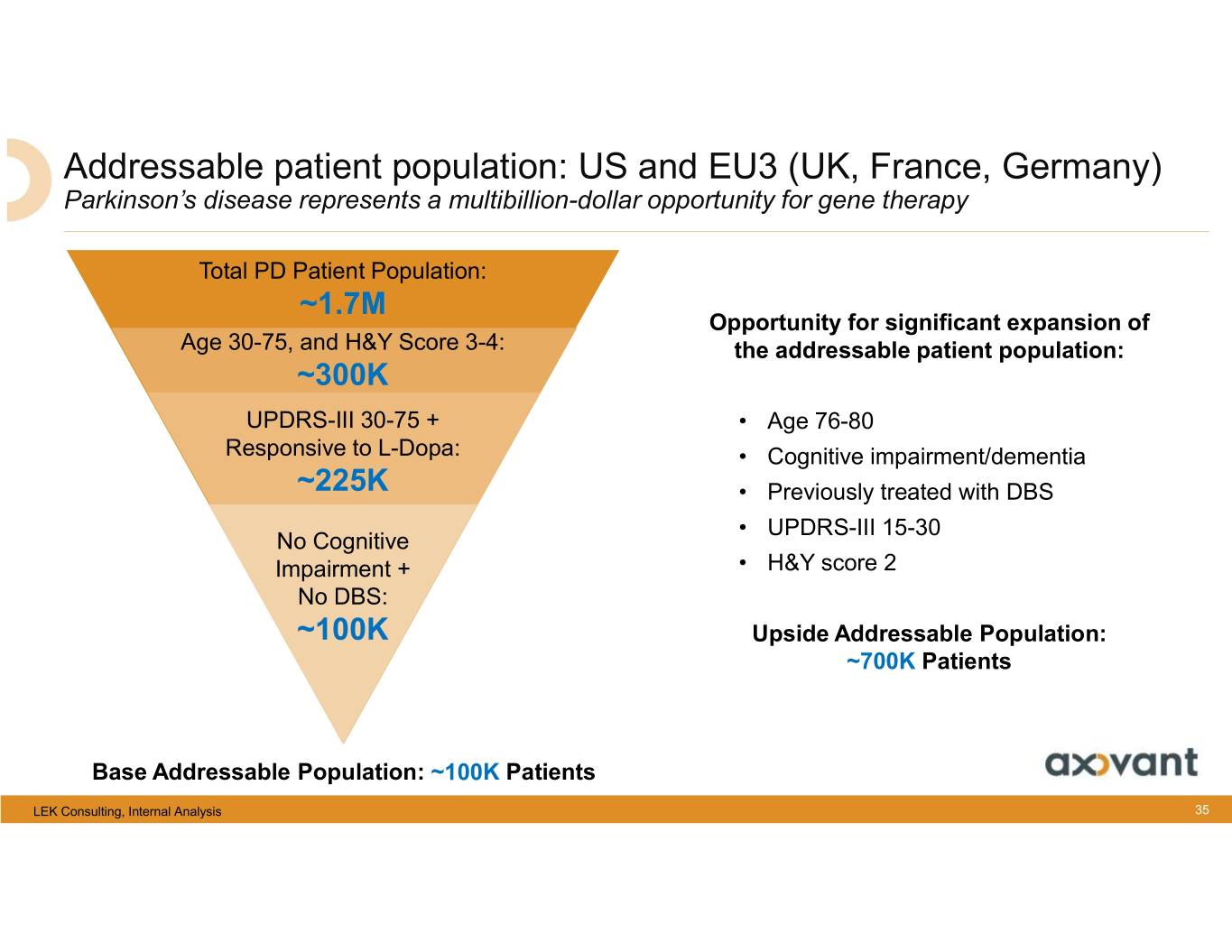
Addressable patient population: US and EU3 (UK, France, Germany) Parkinson’s disease represents a multibillion-dollar opportunity for gene therapy Total PD Patient Population: ~1.7M Opportunity for significant expansion of Age 30-75, and H&Y Score 3-4: the addressable patient population: ~300K UPDRS-III 30-75 + • Age 76-80 Responsive to L-Dopa: • Cognitive impairment/dementia ~225K • Previously treated with DBS • UPDRS-III 15-30 No Cognitive Impairment + • H&Y score 2 No DBS: ~100K Upside Addressable Population: ~700K Patients Base Addressable Population: ~100K Patients LEK Consulting, Internal Analysis 35

12-month change in selected measures of advanced therapies * (Cross-study comparison) VY-AADC1,2 Vercise DBS3 ProSavin4 AXO-Lenti-PD4 5 (Cohort 1) 3 (Cohort 1) 5 (Cohort 2) 2 (Cohort 1) Treatment 115 6 (Cohort 2) 5 (Cohort 3) 4 (Cohort 2) 6 (Cohort 3) Sample Size 8 (Posterior) Control Open-label 37 Open-label Open-label -16 points (Cohort 1) -7 points (Cohort 1) Treatment -14 points (Cohort 2) -12 points † -11 points (Cohort 2) -22 points (Cohort 1) ΔUPDRS-III -15 points (Cohort 3) OFF Score Control Open-label -1 point† Open-label Open-label -6 points (Cohort 1) 0 points (Cohort 1) Treatment NA -1 points (Cohort 2) -13 points (Cohort 1) -4 points (Cohort 2) ΔUPDRS-II -5 points (Cohort 3) OFF Score Control Open-label NA Open-label Open-label -17 points (Cohort 1) -2 points (Cohort 1) Treatment -8 points † -8 points (Cohort 2) -15 points (Cohort 1) -9 points (Cohort 2) ΔPDQ-39 -6 points (Cohort 3) Control Open-label -3 points † Open-label Open-label TM 1: Christine, et al. Ann Neurol. 2019;84(5) 704-714. 3: Vercise DBS for PD Clinical Summary Note: Numbers are rounded *6 months NR = Not reported 2: VYGR Press Release 4. Palfi, et al. 2014, 2018 and Data on file * Data not taken from a head-to-head study †3 months NA = Not assessed 36

AXO-AAV-GM1 and AXO-AAV-GM2 First clinic-ready gene therapies for GM1 gangliosidosis, Tay-Sachs and Sandhoff diseases
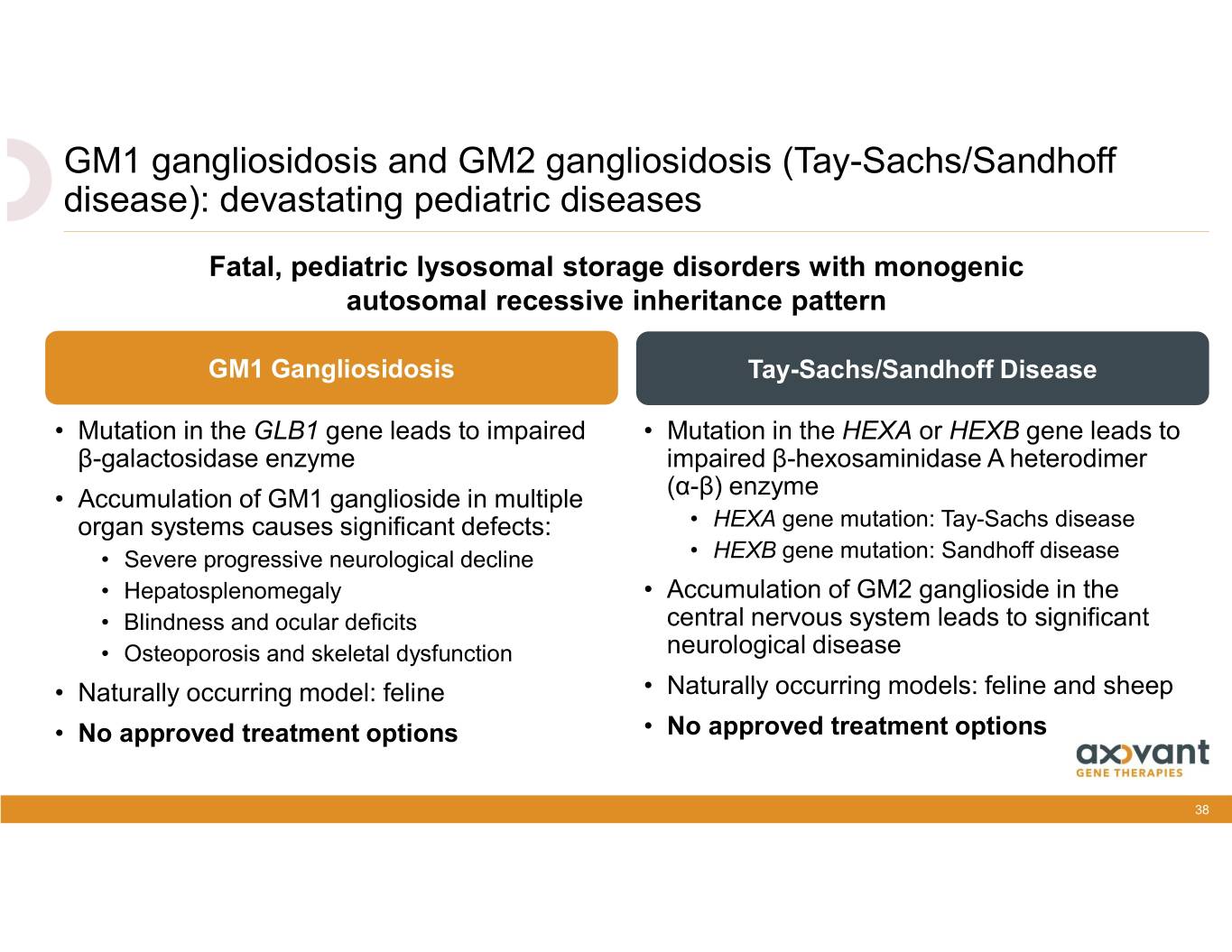
GM1 gangliosidosis and GM2 gangliosidosis (Tay-Sachs/Sandhoff disease): devastating pediatric diseases Fatal, pediatric lysosomal storage disorders with monogenic autosomal recessive inheritance pattern GM1 Gangliosidosis Tay-Sachs/Sandhoff Disease • Mutation in the GLB1 gene leads to impaired • Mutation in the HEXA or HEXB gene leads to β-galactosidase enzyme impaired β-hexosaminidase A heterodimer (α-β) enzyme • Accumulation of GM1 ganglioside in multiple organ systems causes significant defects: • HEXA gene mutation: Tay-Sachs disease • Severe progressive neurological decline • HEXB gene mutation: Sandhoff disease • Hepatosplenomegaly • Accumulation of GM2 ganglioside in the • Blindness and ocular deficits central nervous system leads to significant • Osteoporosis and skeletal dysfunction neurological disease • Naturally occurring model: feline • Naturally occurring models: feline and sheep • No approved treatment options • No approved treatment options 38
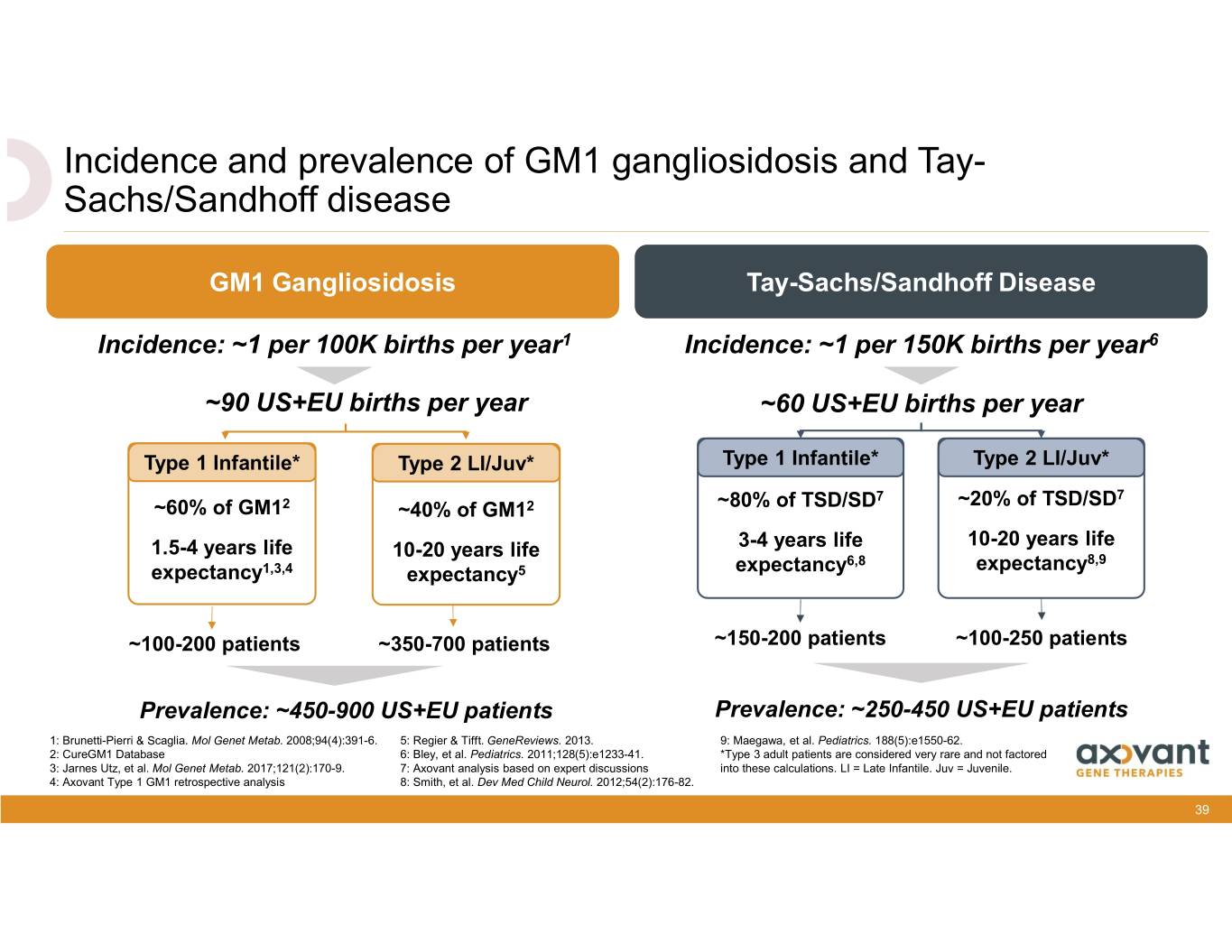
Incidence and prevalence of GM1 gangliosidosis and Tay- Sachs/Sandhoff disease GM1 Gangliosidosis Tay-Sachs/Sandhoff Disease Incidence: ~1 per 100K births per year1 Incidence: ~1 per 150K births per year6 ~90 US+EU births per year ~60 US+EU births per year Type 1 Infantile* Type 2 LI/Juv* Type 1 Infantile* Type 2 LI/Juv* 7 ~20% of TSD/SD7 ~60% of GM12 ~40% of GM12 ~80% of TSD/SD 10-20 years life 1.5-4 years life 10-20 years life 3-4 years life 6,8 expectancy8,9 expectancy1,3,4 expectancy5 expectancy ~100-200 patients ~350-700 patients ~150-200 patients ~100-250 patients Prevalence: ~450-900 US+EU patients Prevalence: ~250-450 US+EU patients 1: Brunetti-Pierri & Scaglia. Mol Genet Metab. 2008;94(4):391-6. 5: Regier & Tifft. GeneReviews. 2013. 9: Maegawa, et al. Pediatrics. 188(5):e1550-62. 2: CureGM1 Database 6: Bley, et al. Pediatrics. 2011;128(5):e1233-41. *Type 3 adult patients are considered very rare and not factored 3: Jarnes Utz, et al. Mol Genet Metab. 2017;121(2):170-9. 7: Axovant analysis based on expert discussions into these calculations. LI = Late Infantile. Juv = Juvenile. 4: Axovant Type 1 GM1 retrospective analysis 8: Smith, et al. Dev Med Child Neurol. 2012;54(2):176-82. 39
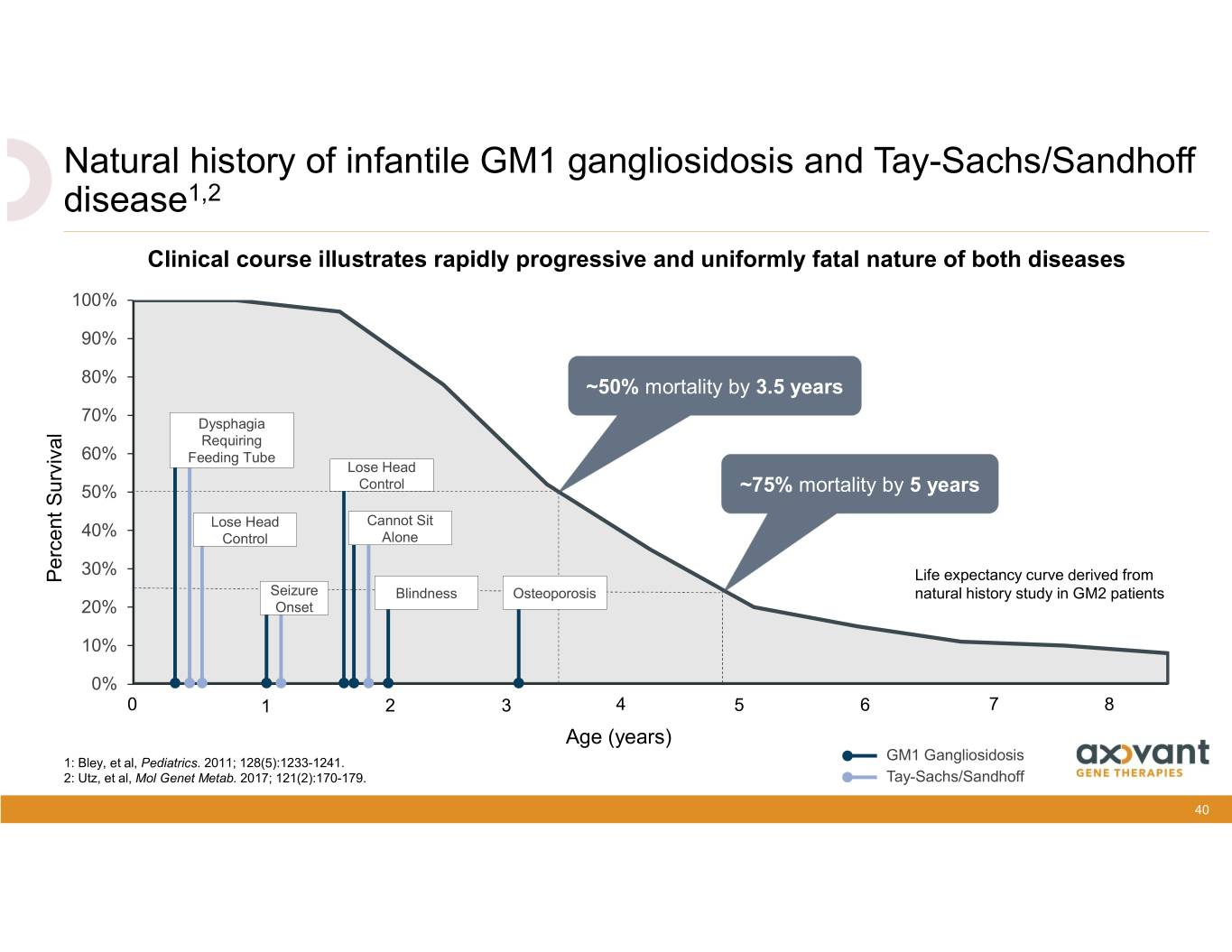
Natural history of infantile GM1 gangliosidosis and Tay-Sachs/Sandhoff disease1,2 Clinical course illustrates rapidly progressive and uniformly fatal nature of both diseases 100% 90% 80% ~50% mortality by 3.5 years 70% Dysphagia Requiring 60% Feeding Tube Lose Head 50% Control ~75% mortality by 5 years Lose Head Cannot Sit 40% Control Alone 30% Percent Survival Percent Life expectancy curve derived from Seizure Blindness Osteoporosis natural history study in GM2 patients 20% Onset 10% 0% 0 1 2 3 45 6 7 8 Age (years) 1: Bley, et al, Pediatrics. 2011; 128(5):1233-1241. GM1 Gangliosidosis 2: Utz, et al, Mol Genet Metab. 2017; 121(2):170-179. Tay-Sachs/Sandhoff 40
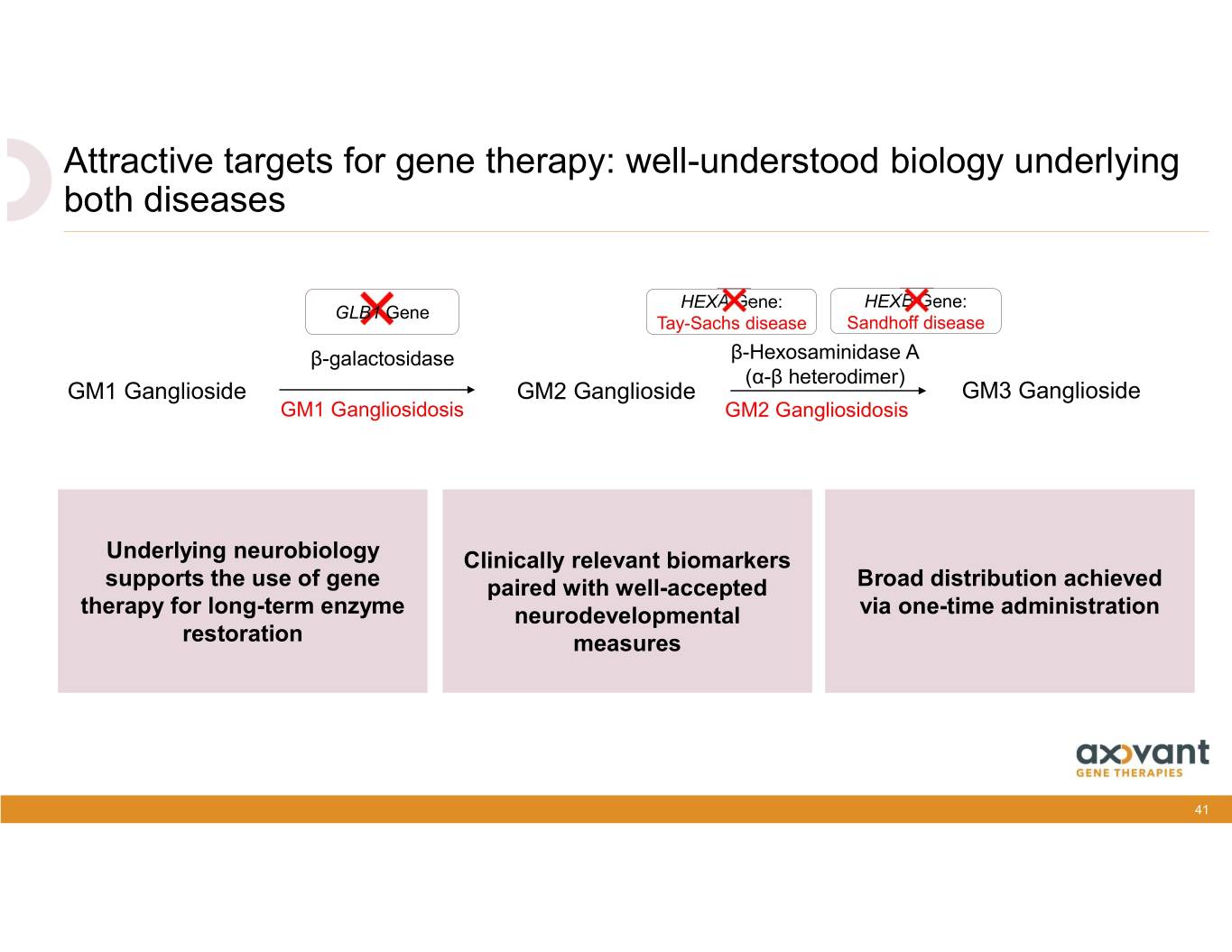
Attractive targets for gene therapy: well-understood biology underlying both diseases HEXA Gene: HEXB Gene: GLB1 Gene Tay-Sachs disease Sandhoff disease β-galactosidase β-Hexosaminidase A (α-β heterodimer) GM1 Ganglioside GM2 Ganglioside GM3 Ganglioside GM1 Gangliosidosis GM2 Gangliosidosis Underlying neurobiology Clinically relevant biomarkers supports the use of gene paired with well-accepted Broad distribution achieved therapy for long-term enzyme neurodevelopmental via one-time administration restoration measures 41

AXO-AAV-GM1 AAV gene therapy for GM1 Gangliosidosis

AXO-AAV-GM1: Gene therapy approach to restore deficient enzyme AXO-AAV-GM1 delivers a functional copy of the GLB1 gene via AAV9 • Single gene defect leads to decreased β-gal enzyme CBA-GLB1 activity and ganglioside accumulation • Well-validated AAV approach in CNS indications Takes advantage of cross-corrective mechanism across CNS and peripheral nervous system • β-galactosidase is secreted from transduced cells and can have effects on neighboring tissues IV delivery with goal to treat systemic manifestations including bone and cardiac abnormalities • Two animal species, including a naturally-occurring cat model, demonstrate increased β-gal enzyme activity, preserved neurobehavioral function, and improved survival • Preclinical models demonstrate broad distribution of β-gal staining across the brain and spinal cord, improved clinical outcome compared to intracranial delivery • IV administration notably easier on young patients compared to alternate routes of administration 43

GM1 gangliosidosis feline model (video) Untreated: 6.4 months Intravenously treated: >2 years Source: Auburn University. 44

Intravenous delivery approach intended to address the multisystem manifestations of GM1 gangliosidosis β-galactosidase GM1, oligosaccharides, keratan sulfate Cerebral atrophy Cardiac abnormalities Hepatosplenomegaly Cherry-red spot Skeletal dysplasia 45
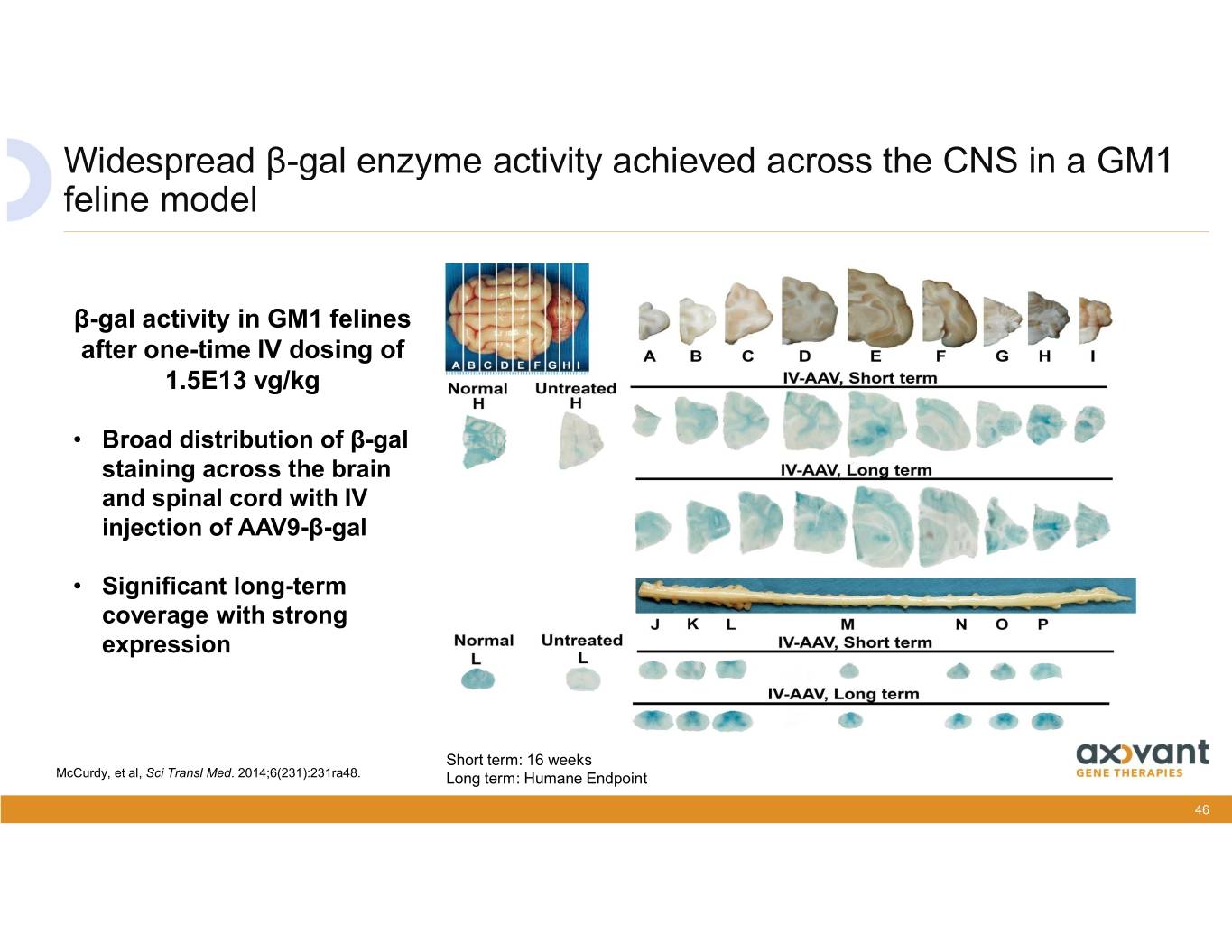
Widespread β-gal enzyme activity achieved across the CNS in a GM1 feline model β-gal activity in GM1 felines after one-time IV dosing of 1.5E13 vg/kg • Broad distribution of β-gal staining across the brain and spinal cord with IV injection of AAV9-β-gal • Significant long-term coverage with strong expression Short term: 16 weeks McCurdy, et al, Sci Transl Med. 2014;6(231):231ra48. Long term: Humane Endpoint 46
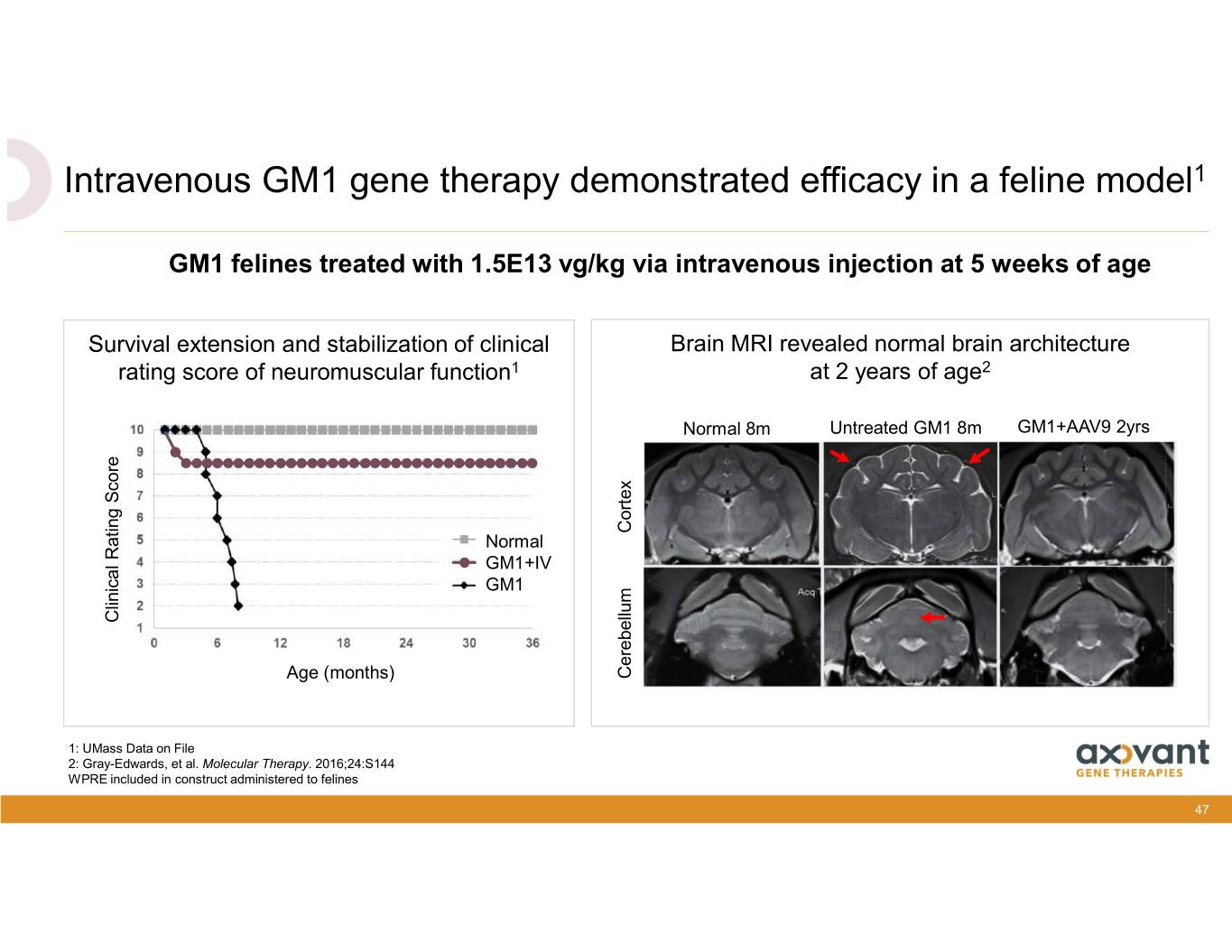
Intravenous GM1 gene therapy demonstrated efficacy in a feline model1 GM1 felines treated with 1.5E13 vg/kg via intravenous injection at 5 weeks of age Survival extension and stabilization of clinical Brain MRI revealed normal brain architecture rating score of neuromuscular function1 at 2 years of age2 Normal 8m Untreated GM1 8m GM1+AAV9 2yrs Cortex Normal GM1+IV GM1 Clinical Rating ScoreRating Clinical Age (months) Cerebellum 1: UMass Data on File 2: Gray-Edwards, et al. Molecular Therapy. 2016;24:S144 WPRE included in construct administered to felines 47
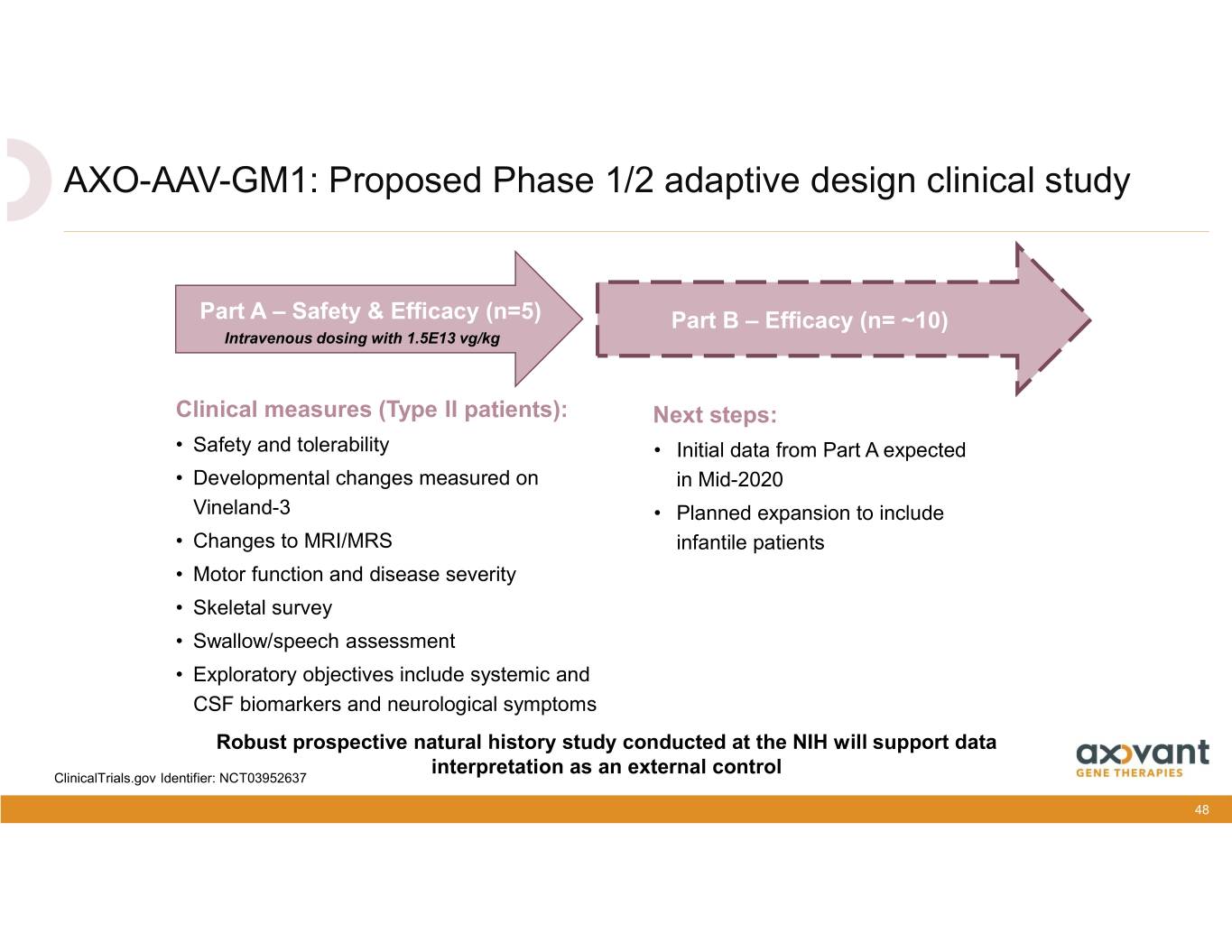
AXO-AAV-GM1: Proposed Phase 1/2 adaptive design clinical study Part A – Safety & Efficacy (n=5) Part B – Efficacy (n= ~10) Intravenous dosing with 1.5E13 vg/kg Clinical measures (Type II patients): Next steps: • Safety and tolerability • Initial data from Part A expected • Developmental changes measured on in Mid-2020 Vineland-3 • Planned expansion to include • Changes to MRI/MRS infantile patients • Motor function and disease severity • Skeletal survey • Swallow/speech assessment • Exploratory objectives include systemic and CSF biomarkers and neurological symptoms Robust prospective natural history study conducted at the NIH will support data interpretation as an external control ClinicalTrials.gov Identifier: NCT03952637 48
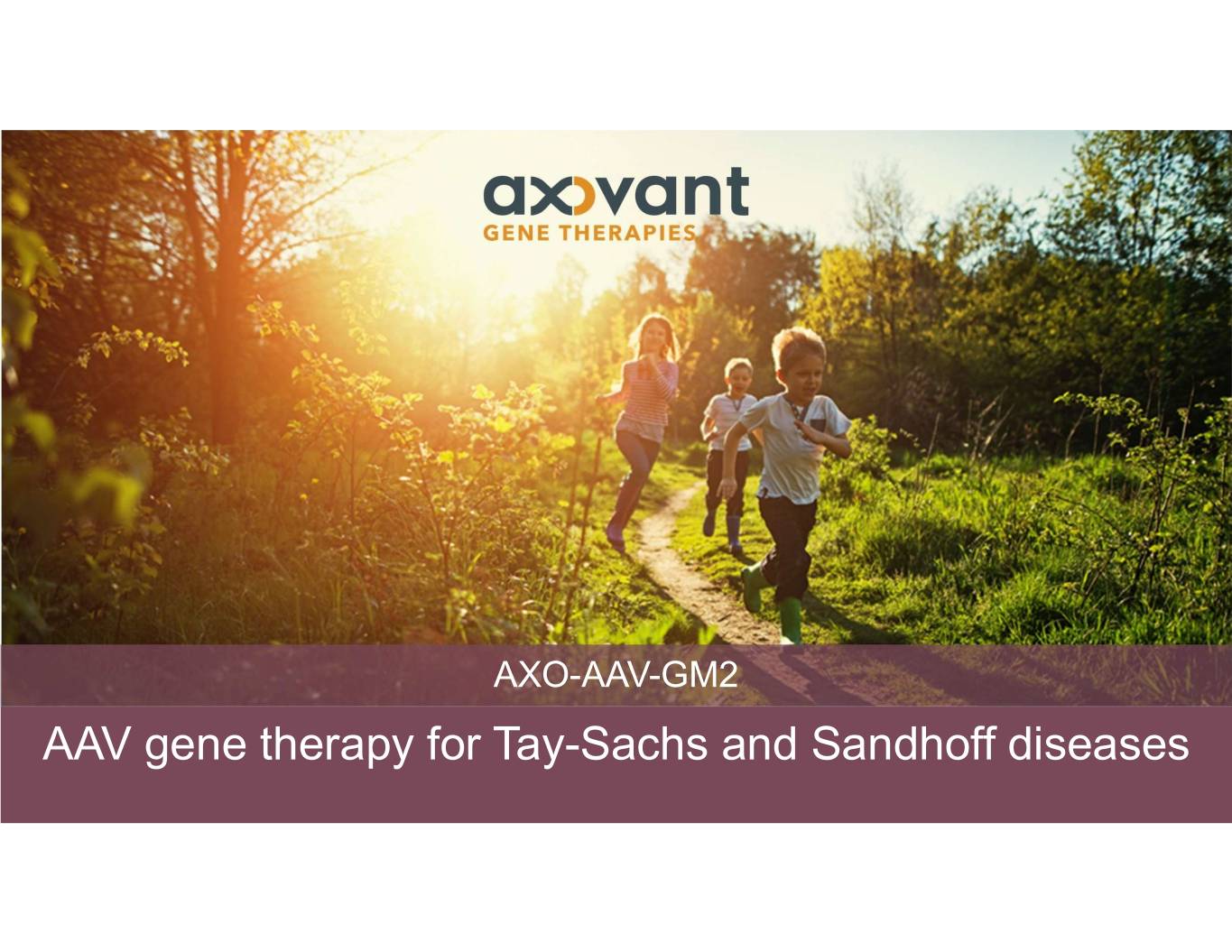
AXO-AAV-GM2 AAV gene therapy for Tay-Sachs and Sandhoff diseases
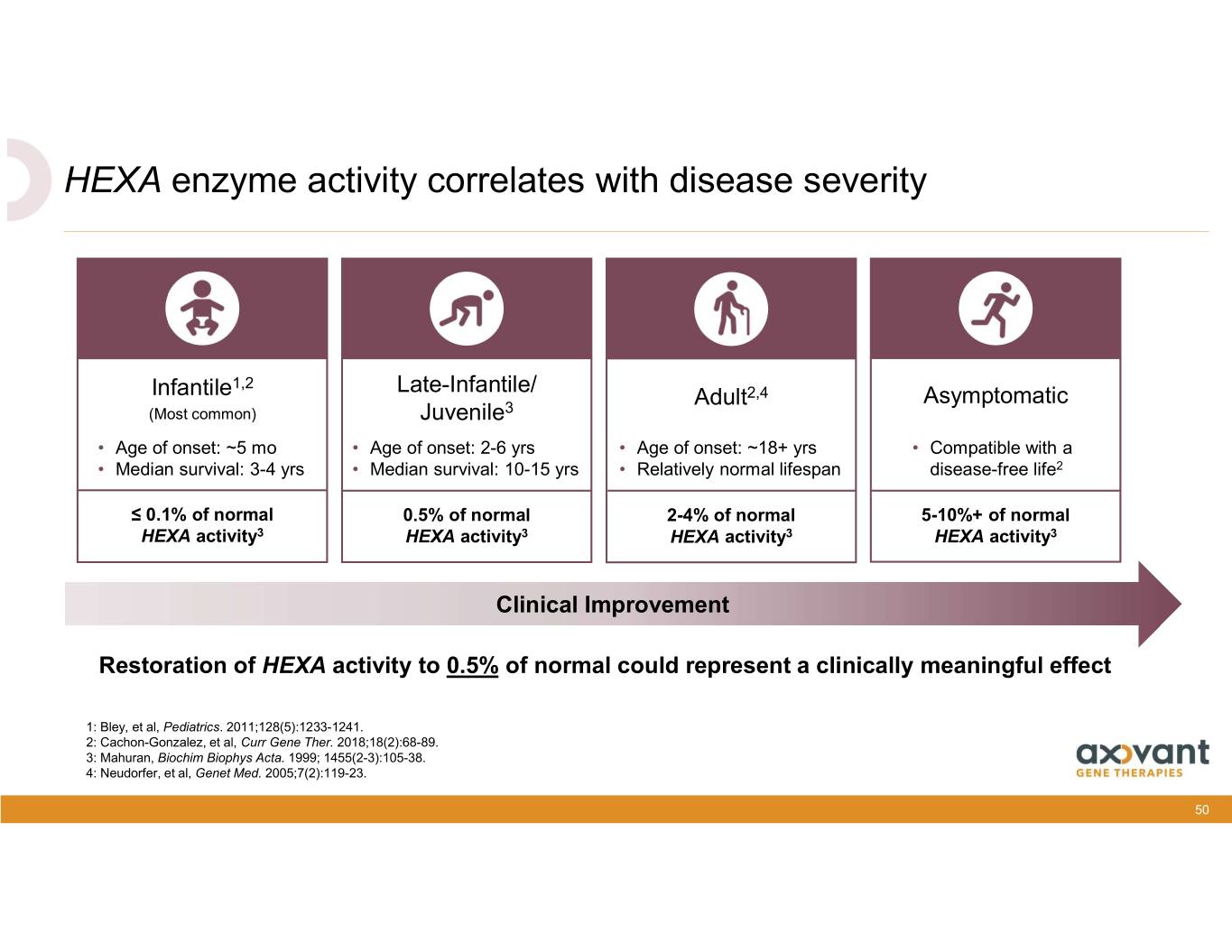
HEXA enzyme activity correlates with disease severity 1,2 Late-Infantile/ Infantile Adult2,4 Asymptomatic (Most common) Juvenile3 • Age of onset: ~5 mo • Age of onset: 2-6 yrs • Age of onset: ~18+ yrs • Compatible with a • Median survival: 3-4 yrs • Median survival: 10-15 yrs • Relatively normal lifespan disease-free life2 ≤ 0.1% of normal 0.5% of normal 2-4% of normal 5-10%+ of normal HEXA activity3 HEXA activity3 HEXA activity3 HEXA activity3 Clinical Improvement Restoration of HEXA activity to 0.5% of normal could represent a clinically meaningful effect 1: Bley, et al, Pediatrics. 2011;128(5):1233-1241. 2: Cachon-Gonzalez, et al, Curr Gene Ther. 2018;18(2):68-89. 3: Mahuran, Biochim Biophys Acta. 1999; 1455(2-3):105-38. 4: Neudorfer, et al, Genet Med. 2005;7(2):119-23. 50
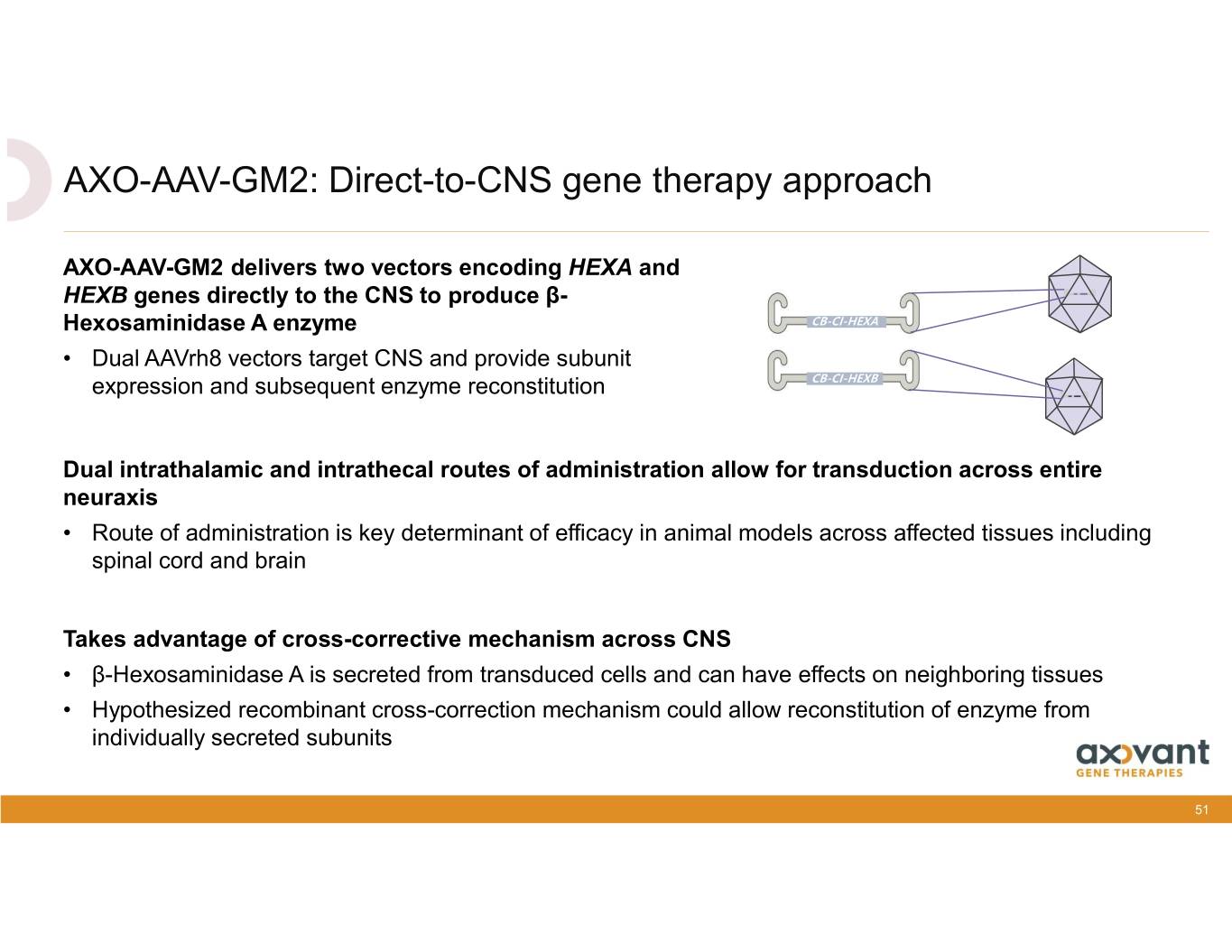
AXO-AAV-GM2: Direct-to-CNS gene therapy approach AXO-AAV-GM2 delivers two vectors encoding HEXA and HEXB genes directly to the CNS to produce β- Hexosaminidase A enzyme CB-CI-HEXA • Dual AAVrh8 vectors target CNS and provide subunit expression and subsequent enzyme reconstitution CB-CI-HEXB Dual intrathalamic and intrathecal routes of administration allow for transduction across entire neuraxis • Route of administration is key determinant of efficacy in animal models across affected tissues including spinal cord and brain Takes advantage of cross-corrective mechanism across CNS • β-Hexosaminidase A is secreted from transduced cells and can have effects on neighboring tissues • Hypothesized recombinant cross-correction mechanism could allow reconstitution of enzyme from individually secreted subunits 51
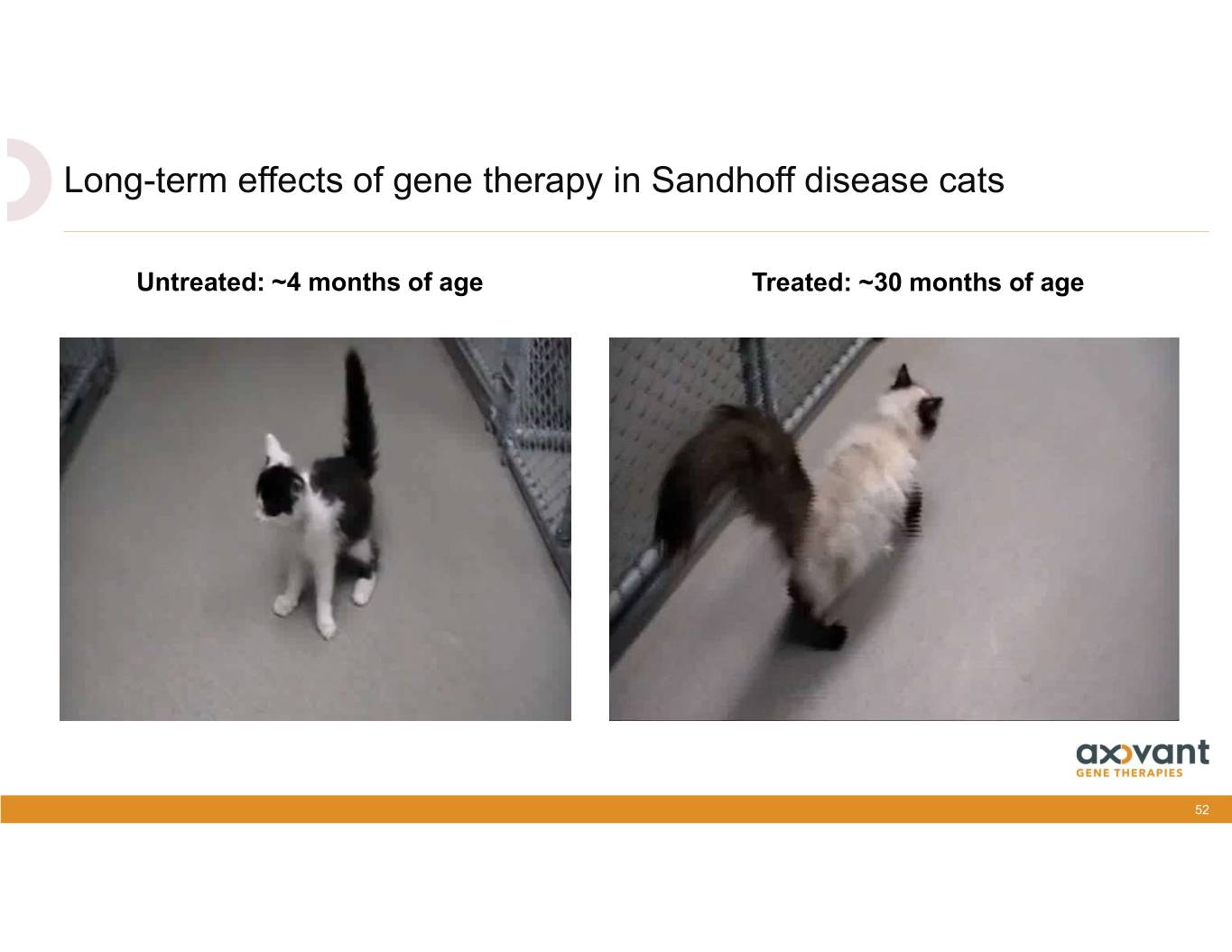
Long-term effects of gene therapy in Sandhoff disease cats Untreated: ~4 months of age Treated: ~30 months of age 52

Long-term effects of gene therapy in Tay-Sachs disease sheep Untreated: ~7.5 months of age Treated: ~13 months of age 53
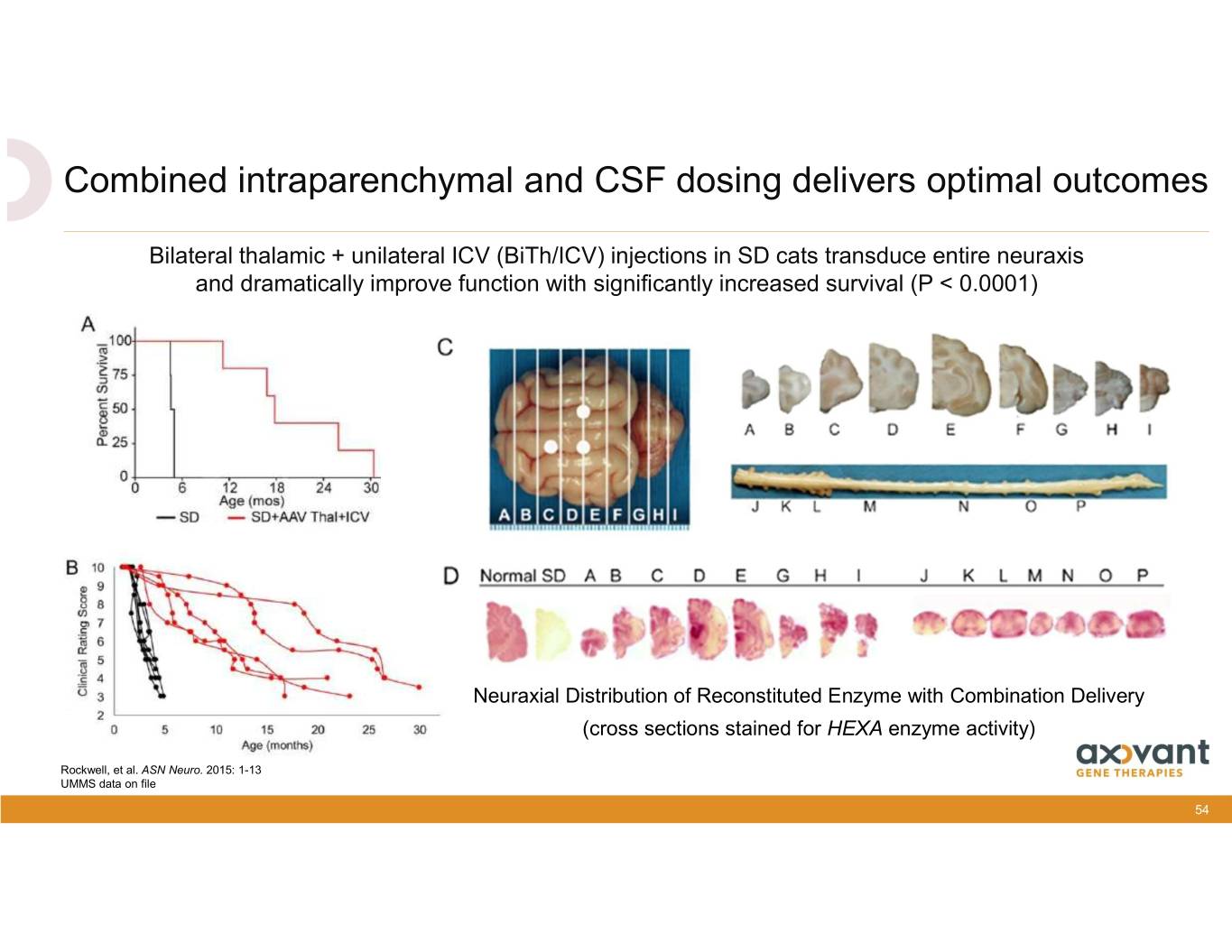
Combined intraparenchymal and CSF dosing delivers optimal outcomes Bilateral thalamic + unilateral ICV (BiTh/ICV) injections in SD cats transduce entire neuraxis and dramatically improve function with significantly increased survival (P < 0.0001) Neuraxial Distribution of Reconstituted Enzyme with Combination Delivery (cross sections stained for HEXA enzyme activity) Rockwell, et al. ASN Neuro. 2015: 1-13 UMMS data on file 54
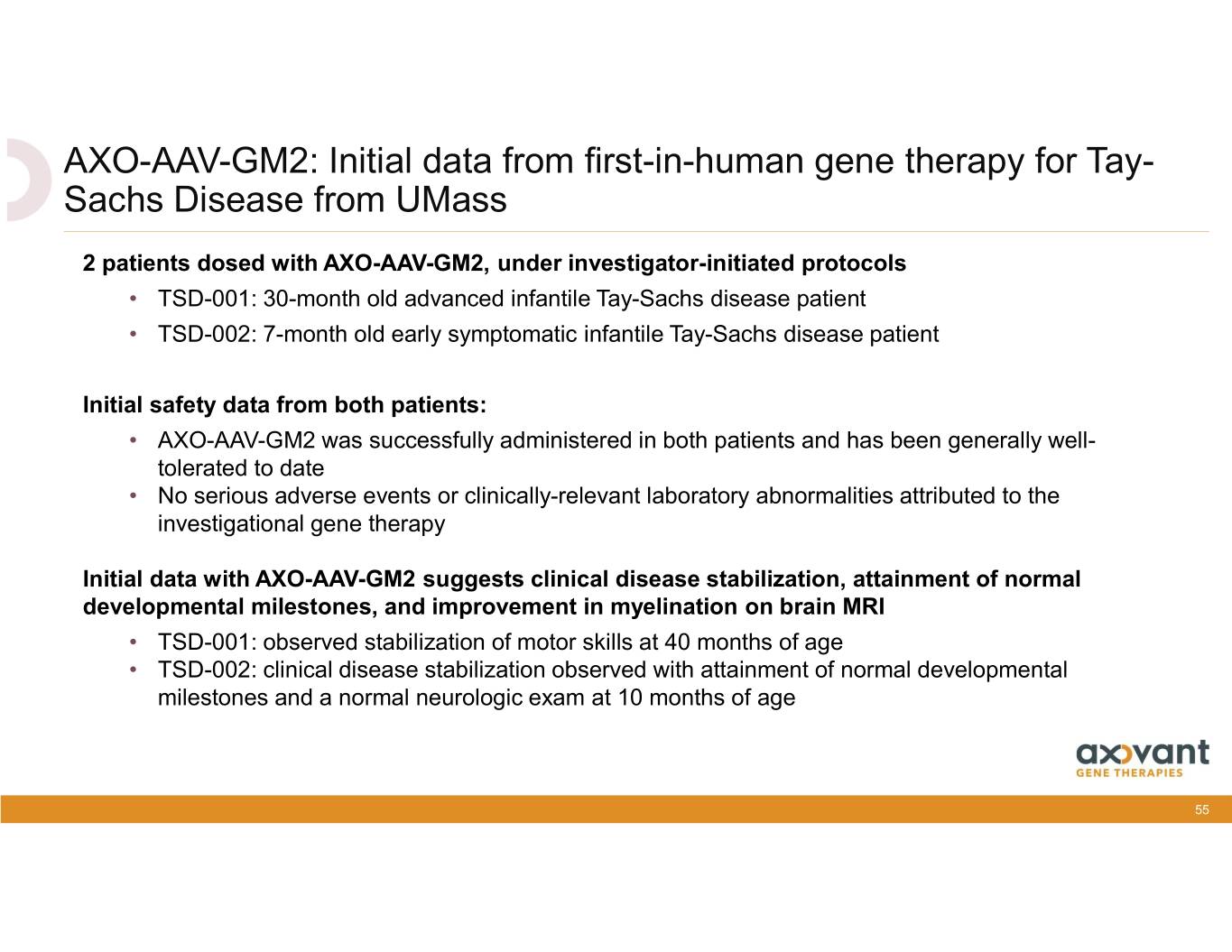
AXO-AAV-GM2: Initial data from first-in-human gene therapy for Tay- Sachs Disease from UMass 2 patients dosed with AXO-AAV-GM2, under investigator-initiated protocols • TSD-001: 30-month old advanced infantile Tay-Sachs disease patient • TSD-002: 7-month old early symptomatic infantile Tay-Sachs disease patient Initial safety data from both patients: • AXO-AAV-GM2 was successfully administered in both patients and has been generally well- tolerated to date • No serious adverse events or clinically-relevant laboratory abnormalities attributed to the investigational gene therapy Initial data with AXO-AAV-GM2 suggests clinical disease stabilization, attainment of normal developmental milestones, and improvement in myelination on brain MRI • TSD-001: observed stabilization of motor skills at 40 months of age • TSD-002: clinical disease stabilization observed with attainment of normal developmental milestones and a normal neurologic exam at 10 months of age 55

TSD-002 – Second patient dosed with AXO-AAV-GM2: expanded access protocol A mildly symptomatic infantile TSD patient dosed bilaterally into thalamus and cisterna magna Age: 6 month old, female Family History: Two untreated older siblings with Thalamus Tay Sachs disease Cisterna • Siblings exhibited rapid disease progression, magna and clinical regression and seizure onset at 12-18 Lumbar months of age spinal cord Birth 3 to 4 months – Disease onset • 1.0 x 1014 vg of AXO-AAV-GM2 split between • Cherry red spot on macula thalamus (bilateral) and intrathecal 6 months – Screened • Current status: 7 months – Dosed • Clinically well at present with a stable exam, 10 months normal growth and development • Clinically stable with normal development • No evidence of seizures or exaggerated startle responses 56
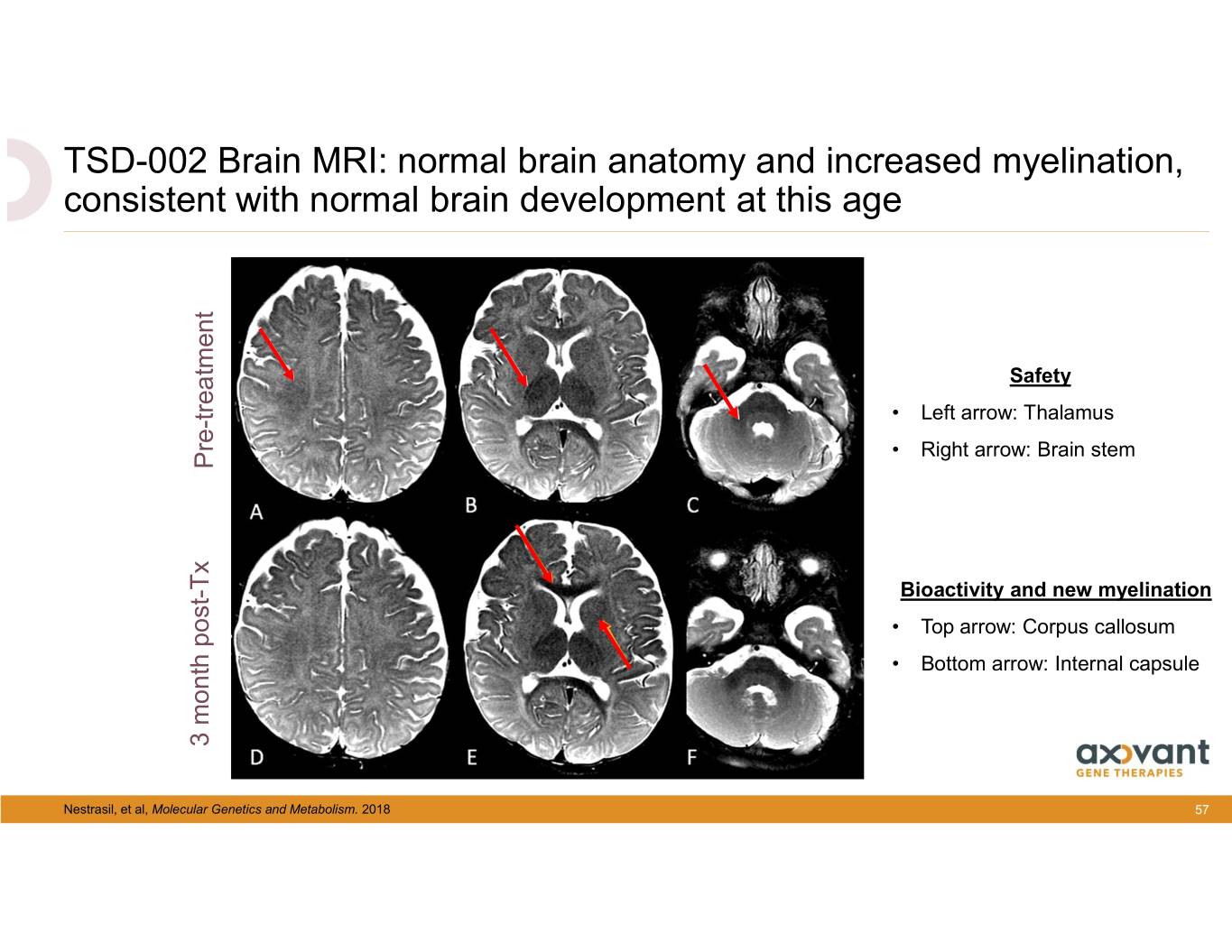
TSD-002 Brain MRI: normal brain anatomy and increased myelination, consistent with normal brain development at this age Safety • Left arrow: Thalamus • Right arrow: Brain stem Pre-treatment Bioactivity and new myelination • Top arrow: Corpus callosum • Bottom arrow: Internal capsule 3 3 month post-Tx Nestrasil, et al, Molecular Genetics and Metabolism. 2018 57

First two patients dosed with AXO-AAV-GM2: Observed stabilization of motor skills as measured by CHOP INTEND* 64 61 61 59 60 First Expanded Access Patient 60 58 58 56 (TSD-001) 52 • CHOP INTEND baseline total score 48 of 14, increasing to 18 44 40 36 Second Expanded Access Patient 32 (TSD-002) 28 23 • CHOP INTEND total score of 58 at 24 18 18 18 baseline, increasing to 61 20 16 16 CHOP INTEND Score CHOPINTEND 16 14 14 • No loss or gain of milestones 12 8 Clinically Meaningful Improvement 4 0 • Total scores sustained >40 points Baseline Week 1 Week 2 Week 3 Month 1 Month 2 Month 3 Month 6 indicates a clinically meaningful Time from Administration improvement TSD-001 TSD-002 Clinically Meaningful Improvement Range *CHOP INTEND (Children’s Hospital of Philadelphia Infant Test of Neuromuscular Disorders) is a 16-item measure of motor skills with a total range of 0 – 64, where zero equals no response and 64 equals a complete response 58

Natural history of infantile GM2: Tay-Sachs and Sandhoff diseases Clinical course illustrates rapidly progressive and uniformly fatal nature of infantile form of both diseases AGE (MONTHS) 0 1 2 3 4 Gain Loss Sitting without propping Most early motor milestones are gained and subsequently Gain Loss Transfer from hand to hand lost within a ~1-year time frame Gain Loss Head control Gain Loss Reach for object ENDPOINTS • Motor milestone gain / loss Seizure onset • Auditory assessments Blindness • Visual assessments Deafness • MRI changes Bley, et al, Pediatrics. 2011; 128(5):1233-1241. Jarnes Utz, et al, Mol Genet Metab. 2017; 121(2):170-179 59

AXO-AAV-GM2: Proposed Phase 1/2 adaptive design clinical study for infantile and juvenile Tay-Sachs/Sandhoff disease patients Part A – Dose-Ranging Part B – Efficacy (n = ~7) (n = ~10) Clinical measures: Next steps: • Safety and tolerability • Part A study initiation in 2020 • Enzyme activity in CSF and serum • GM2 ganglioside levels in CSF • Changes to MRI/MRS • Motor function and disease severity • Exploratory objectives include other systemic and CSF biomarkers and neurological symptoms 60
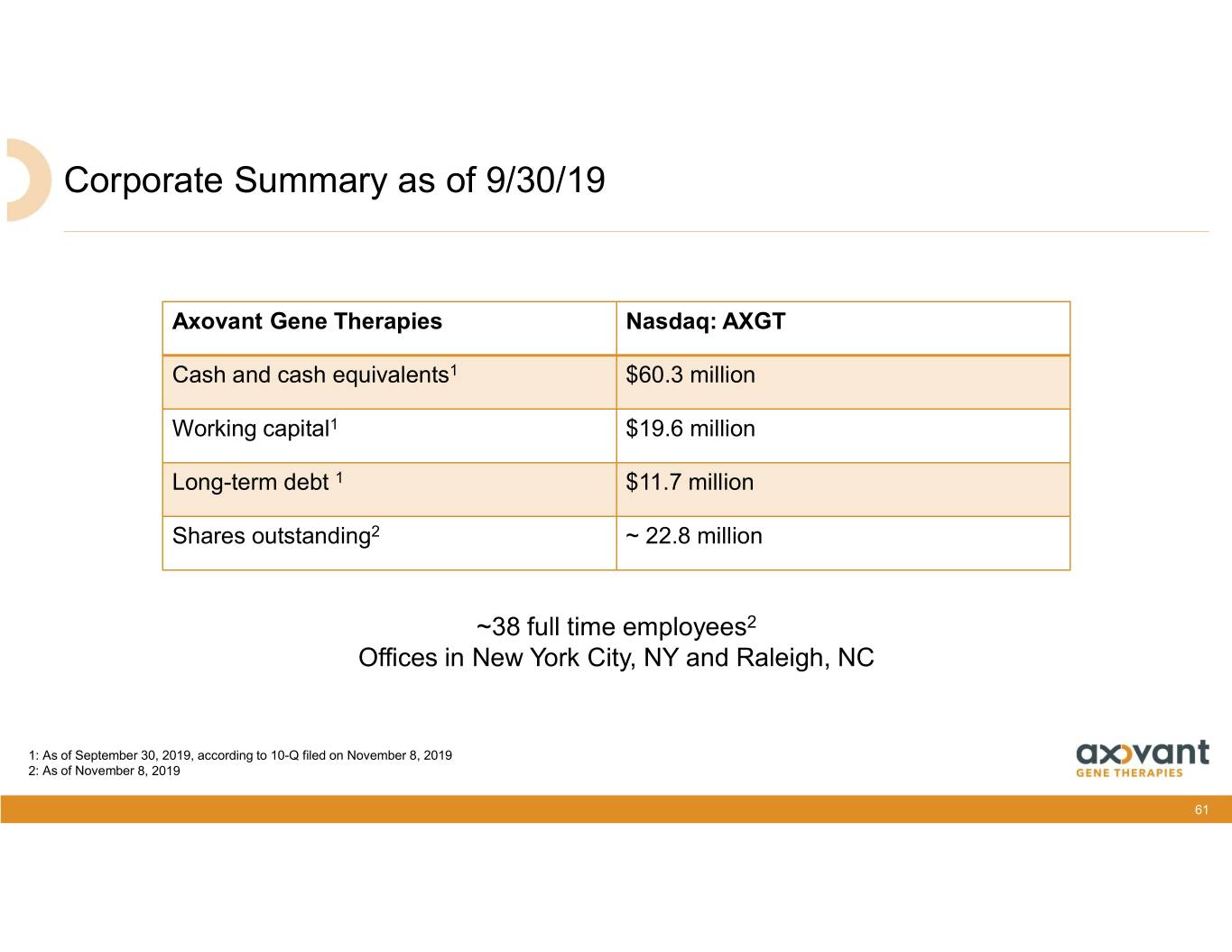
Corporate Summary as of 9/30/19 Axovant Gene Therapies Nasdaq: AXGT Cash and cash equivalents1 $60.3 million Working capital1 $19.6 million Long-term debt 1 $11.7 million Shares outstanding2 ~ 22.8 million ~38 full time employees2 Offices in New York City, NY and Raleigh, NC 1: As of September 30, 2019, according to 10-Q filed on November 8, 2019 2: As of November 8, 2019 61

Every day matters. Every life matters. 62
